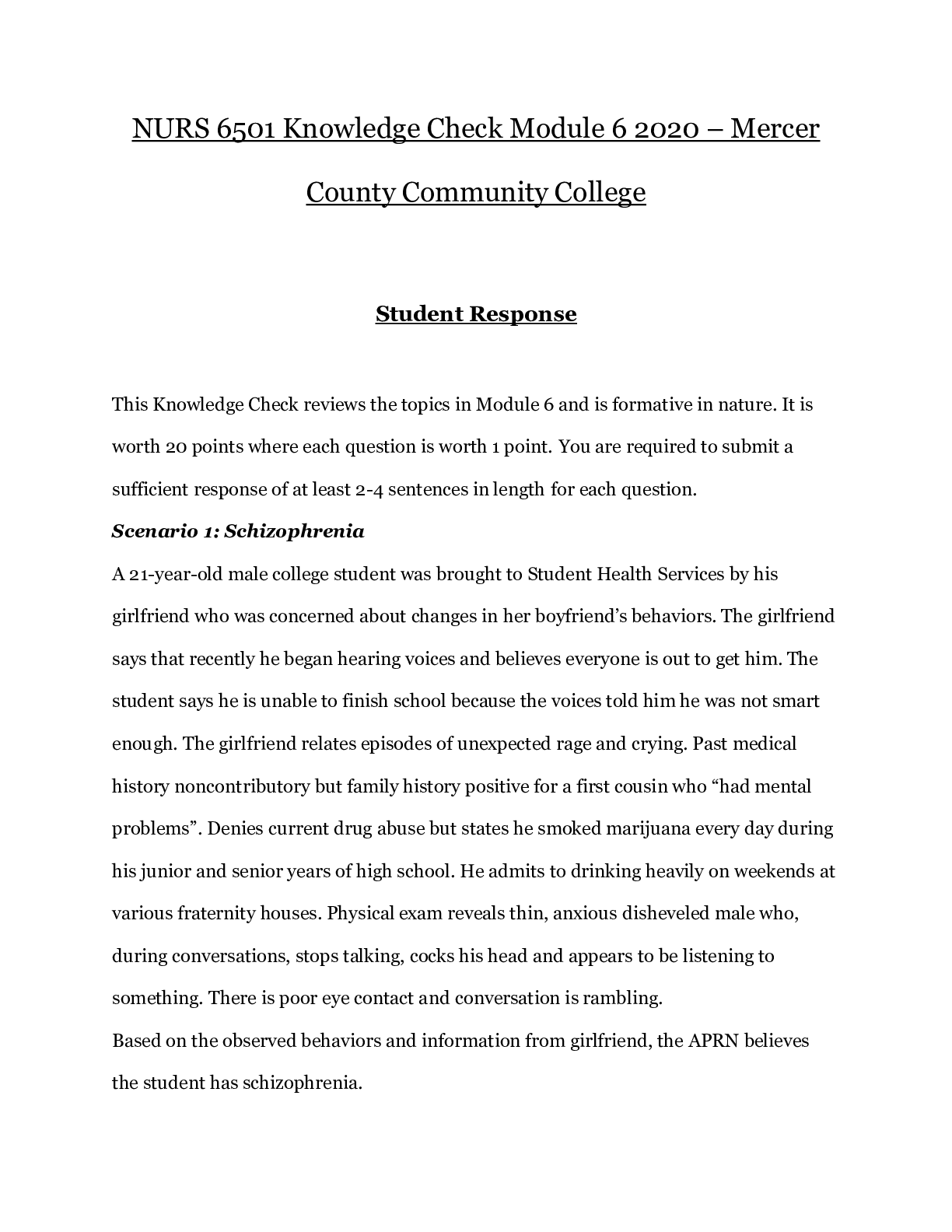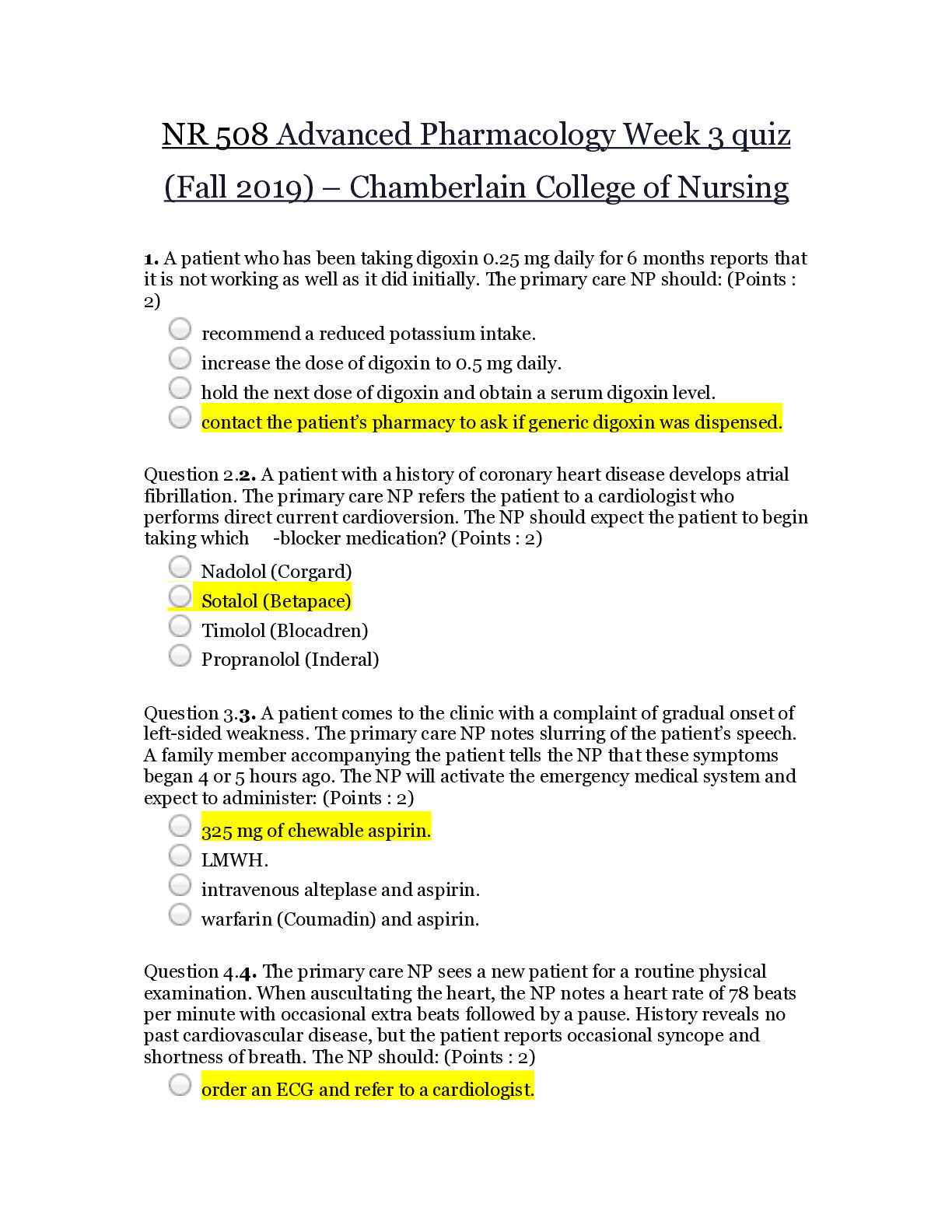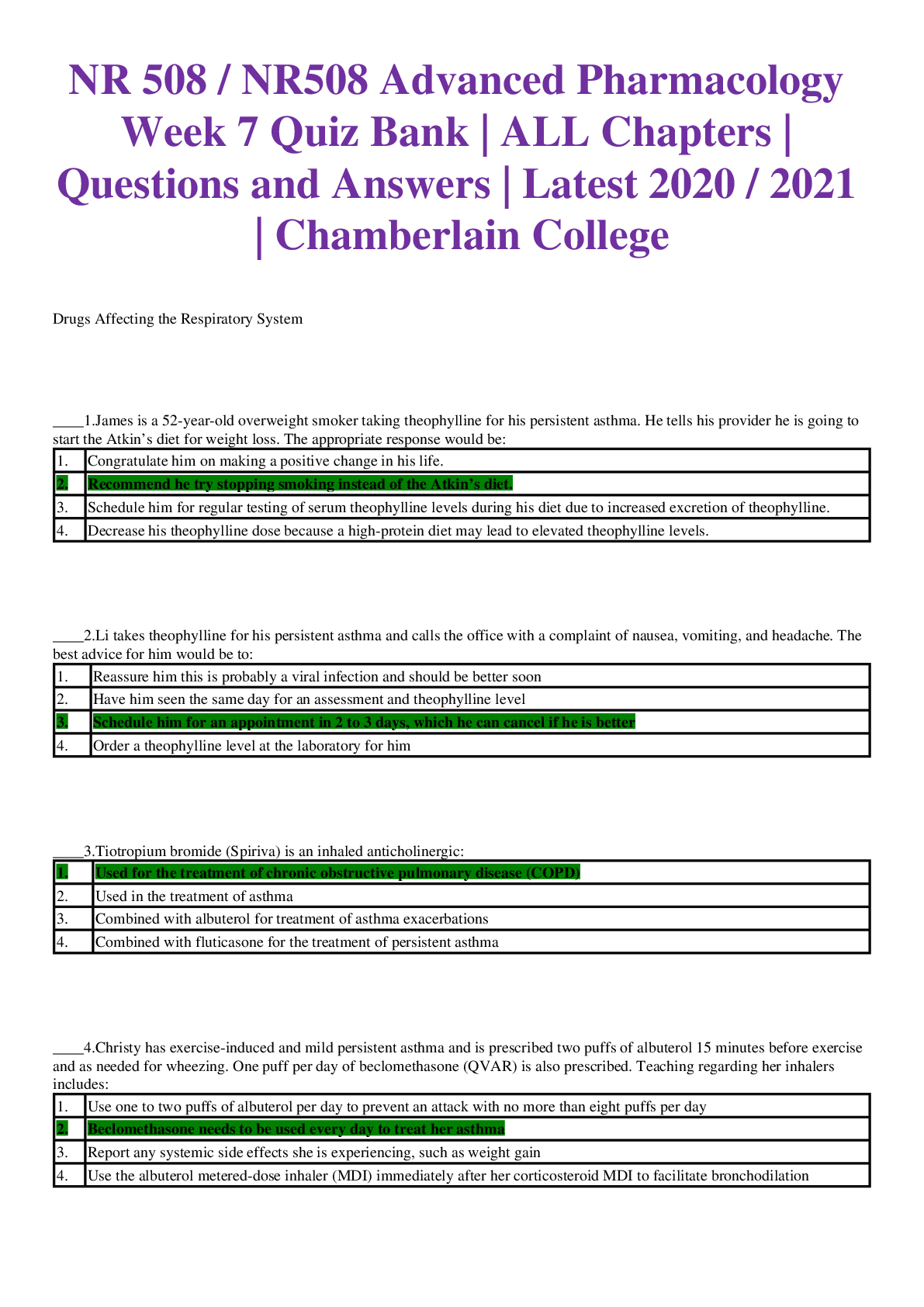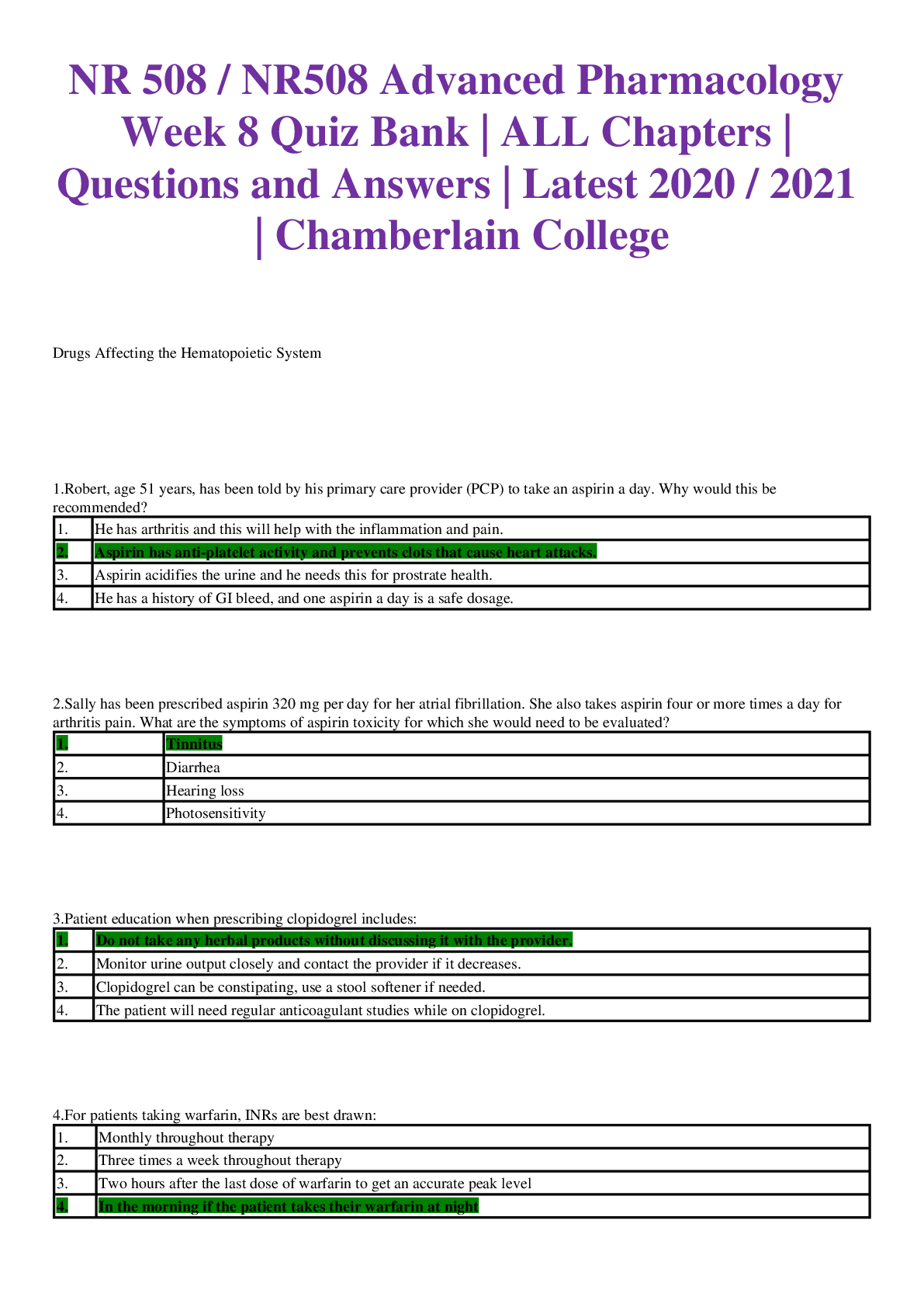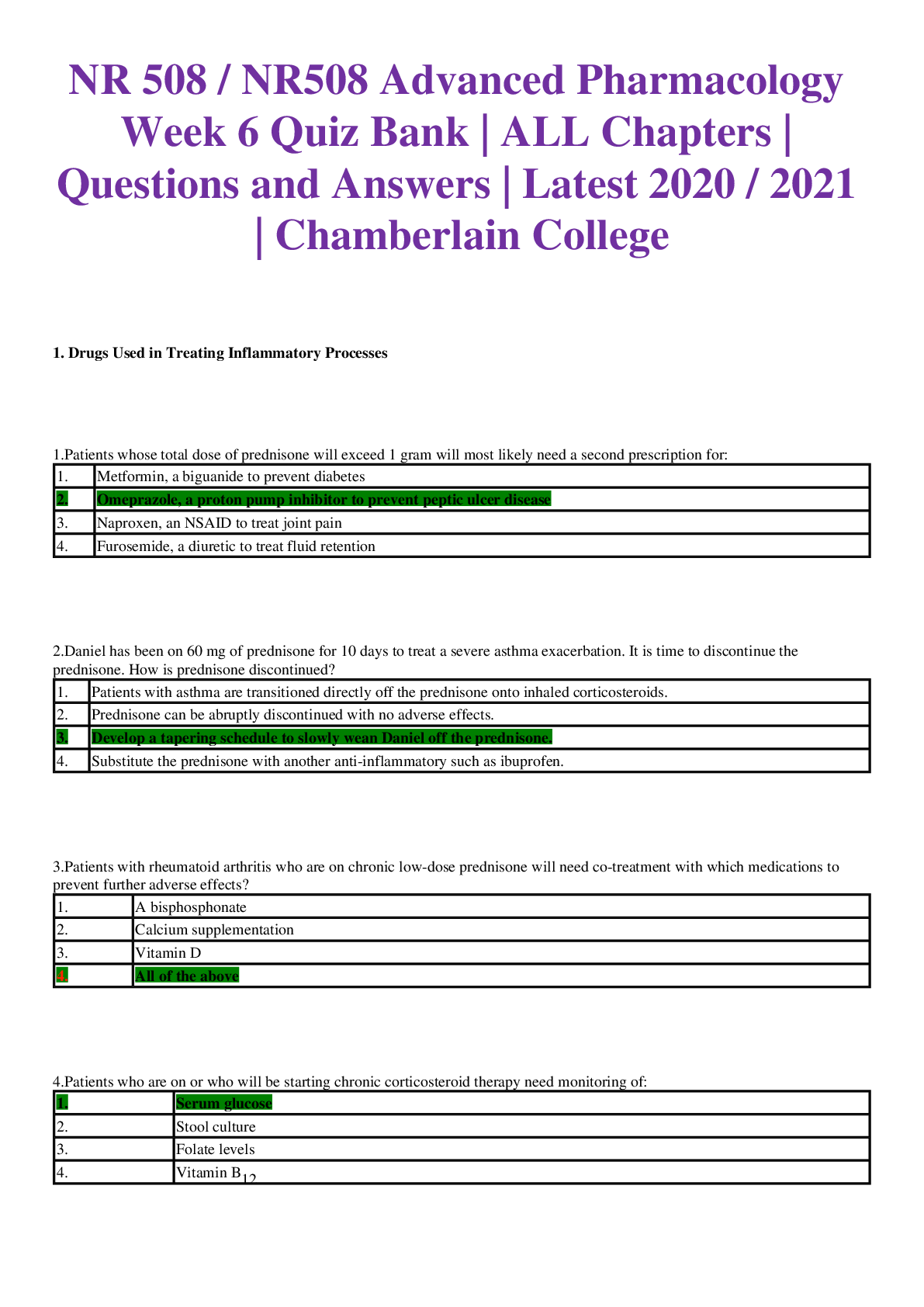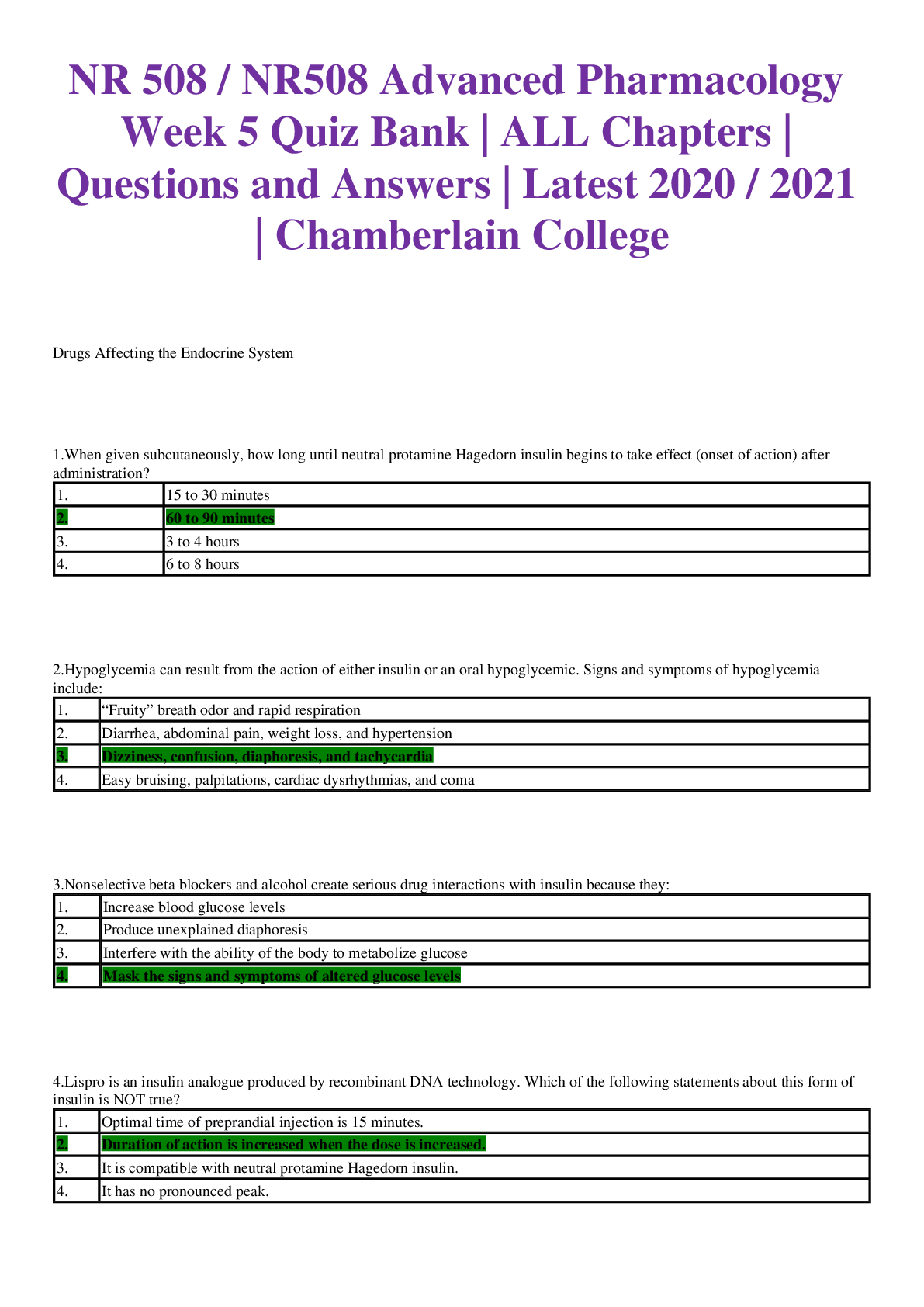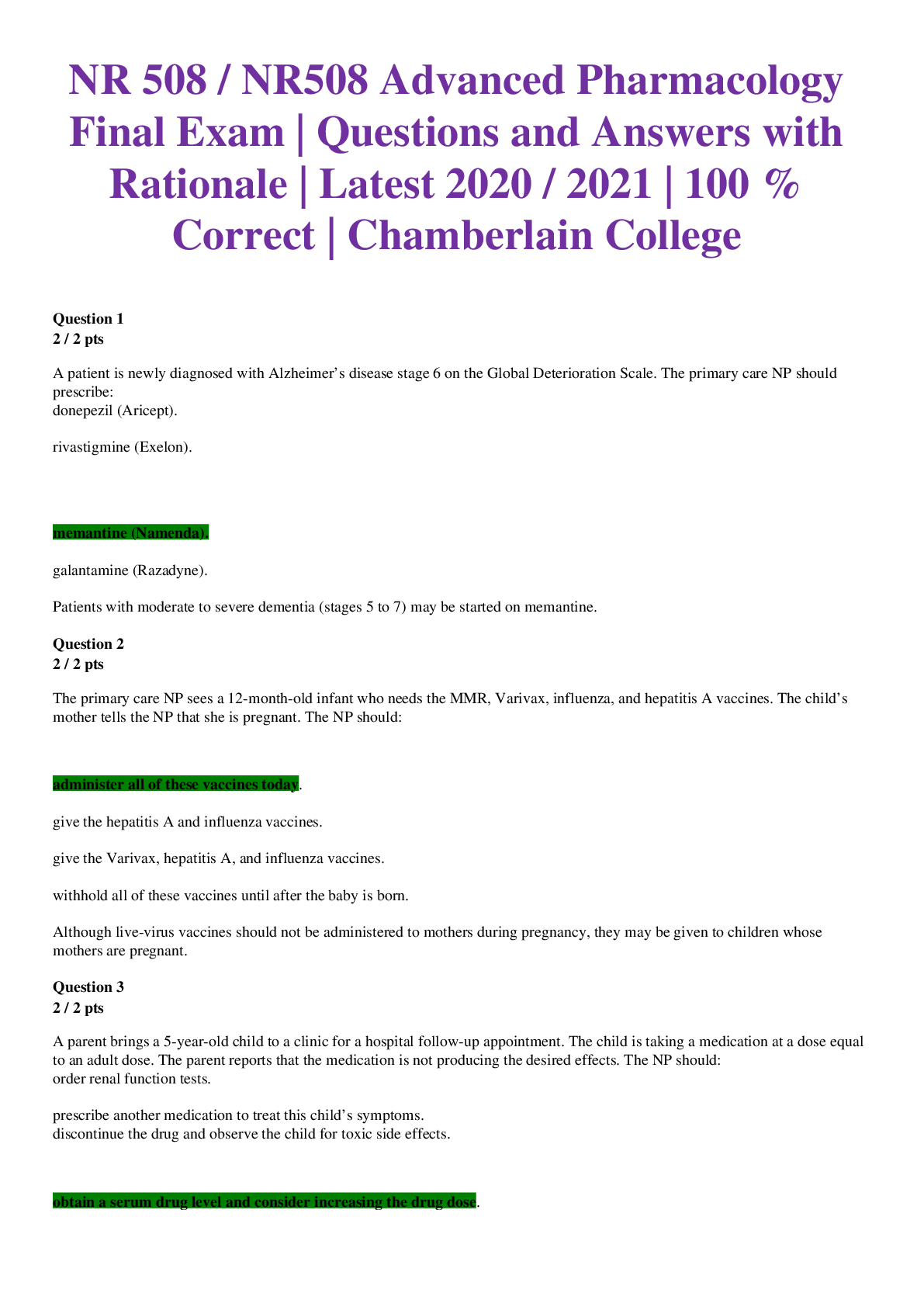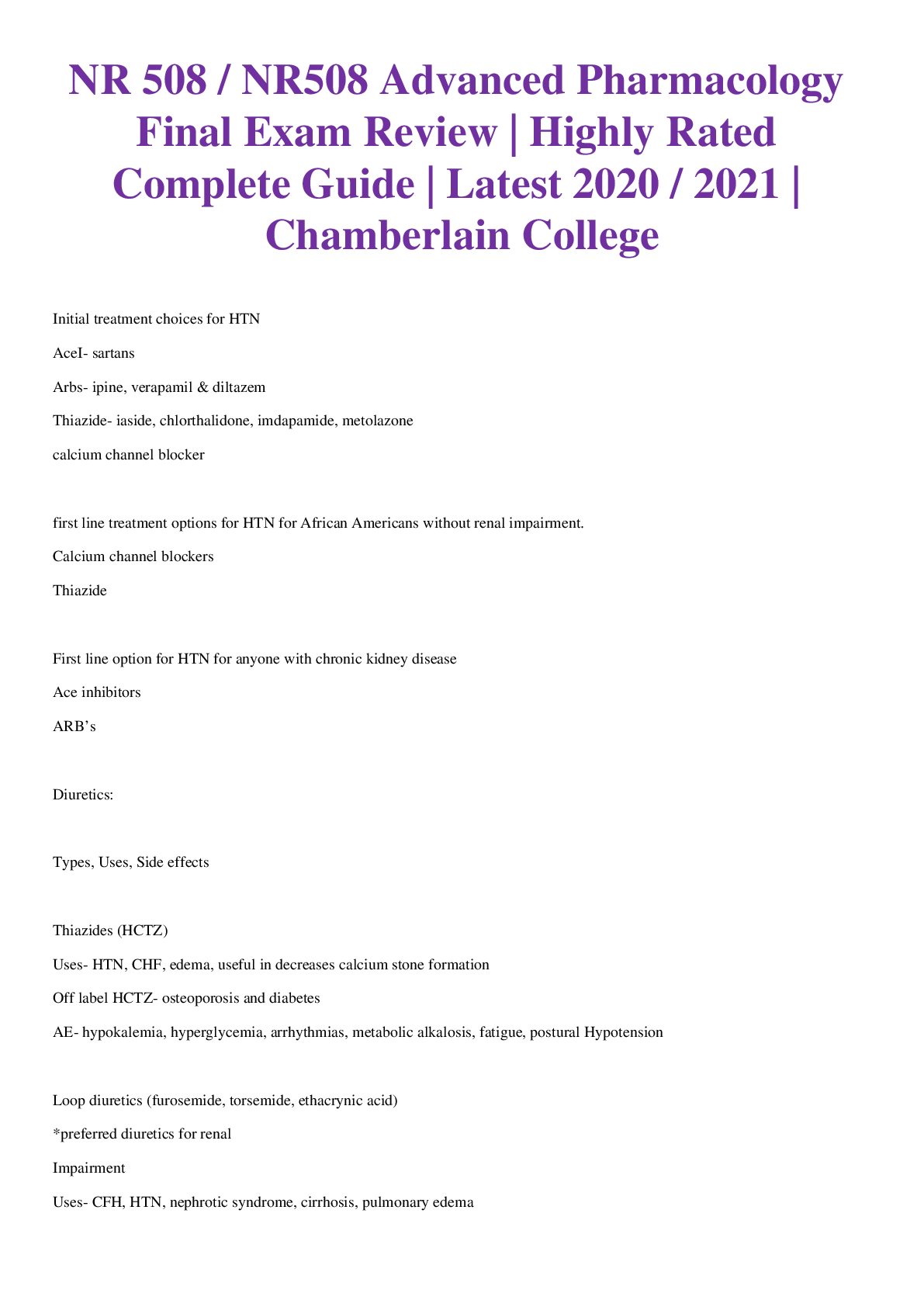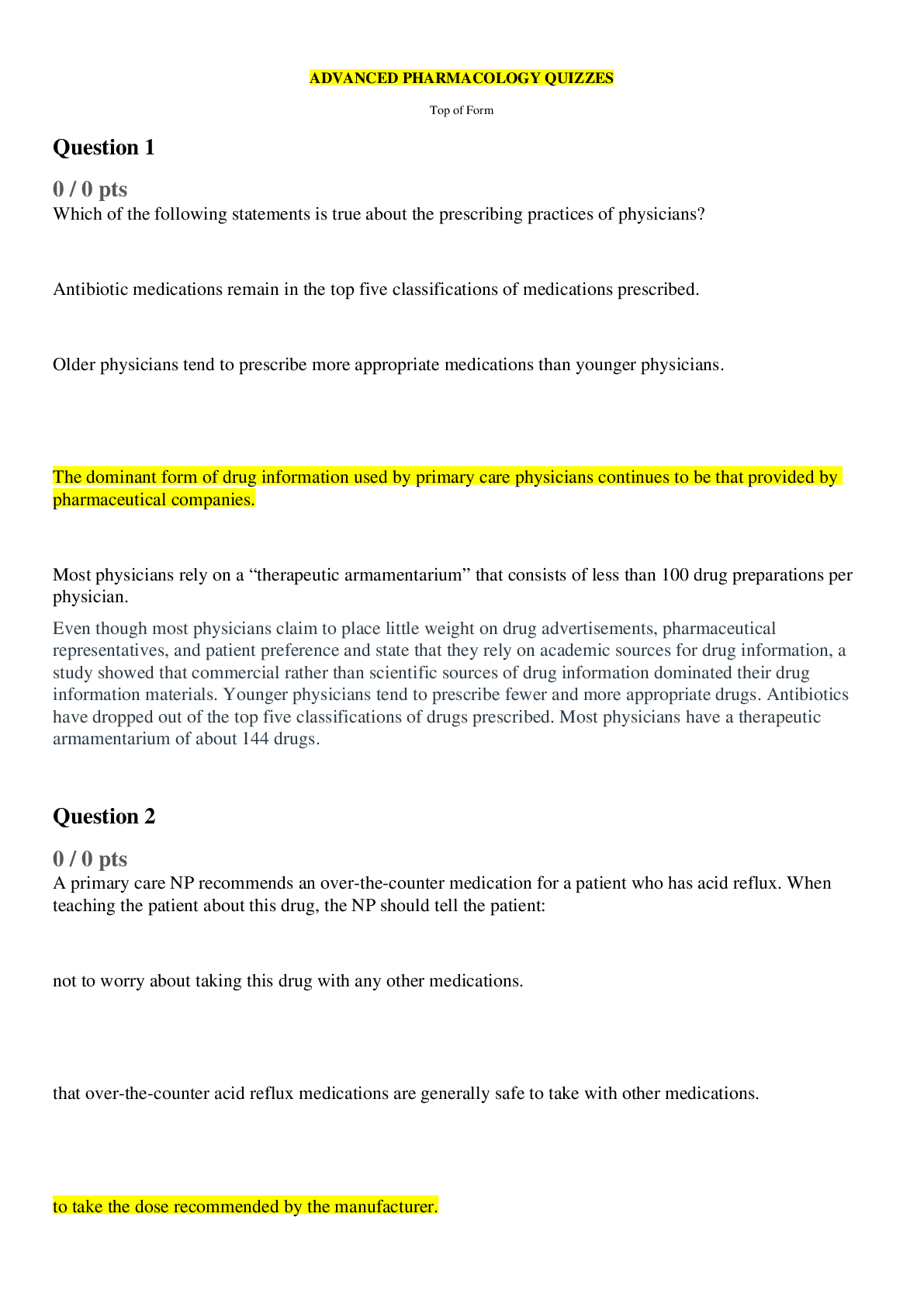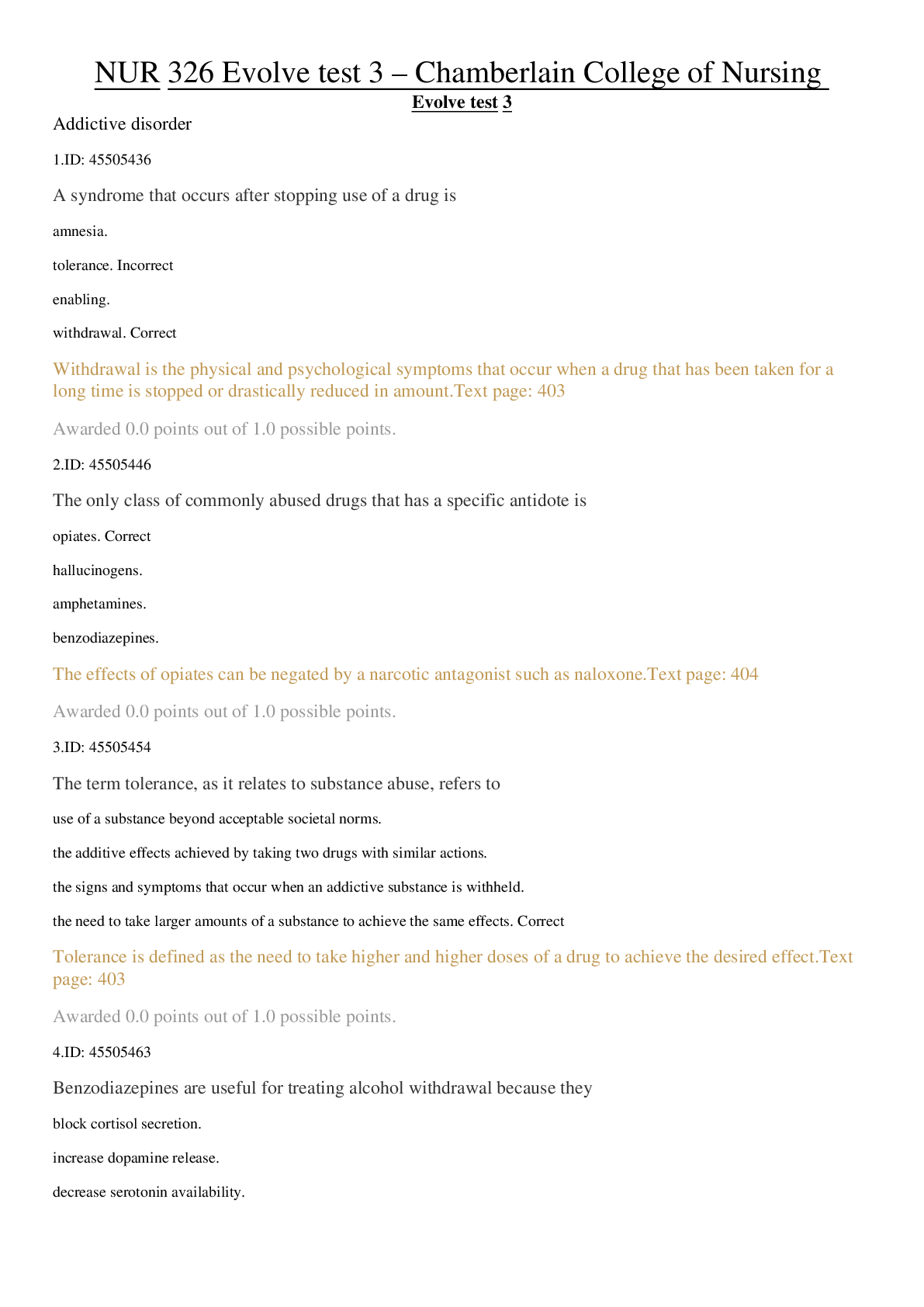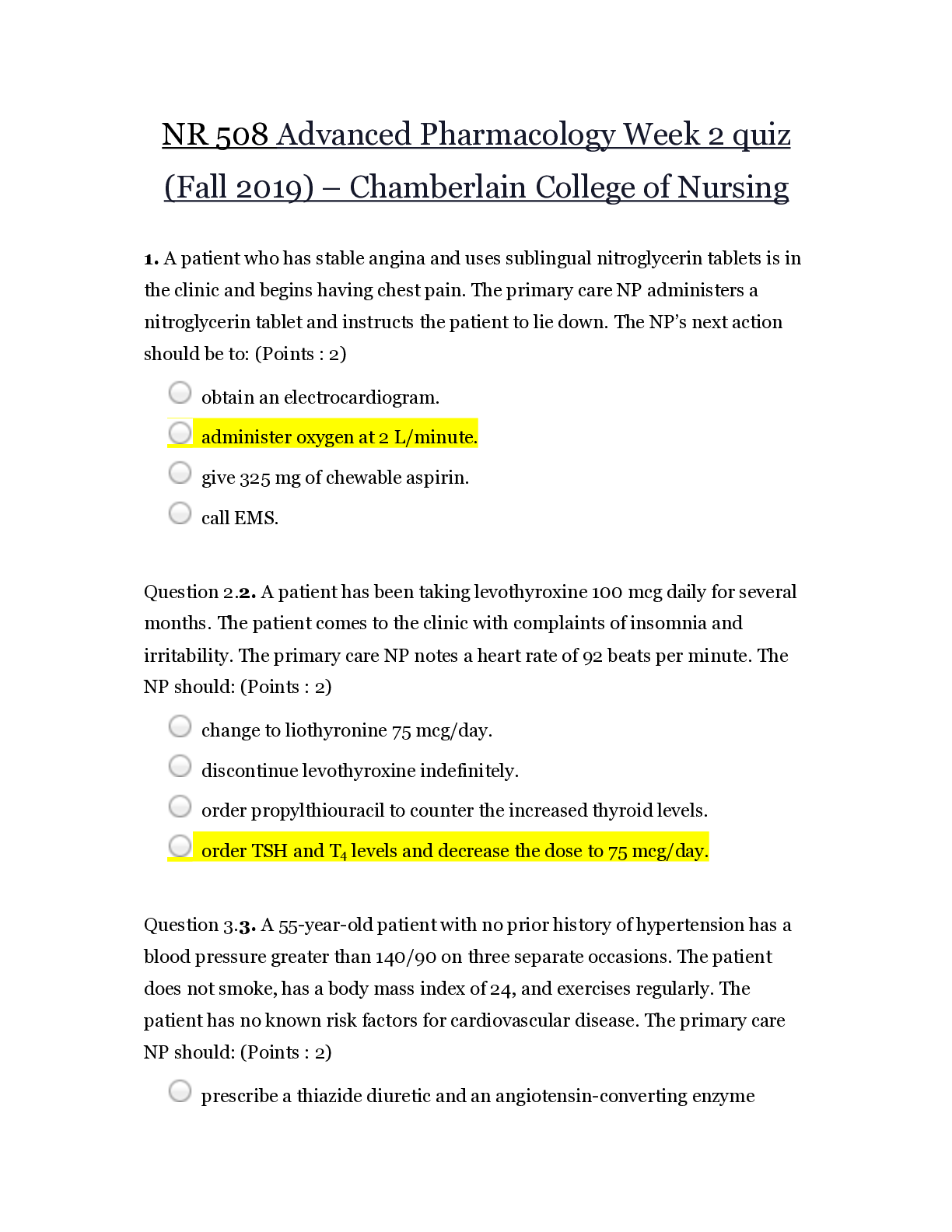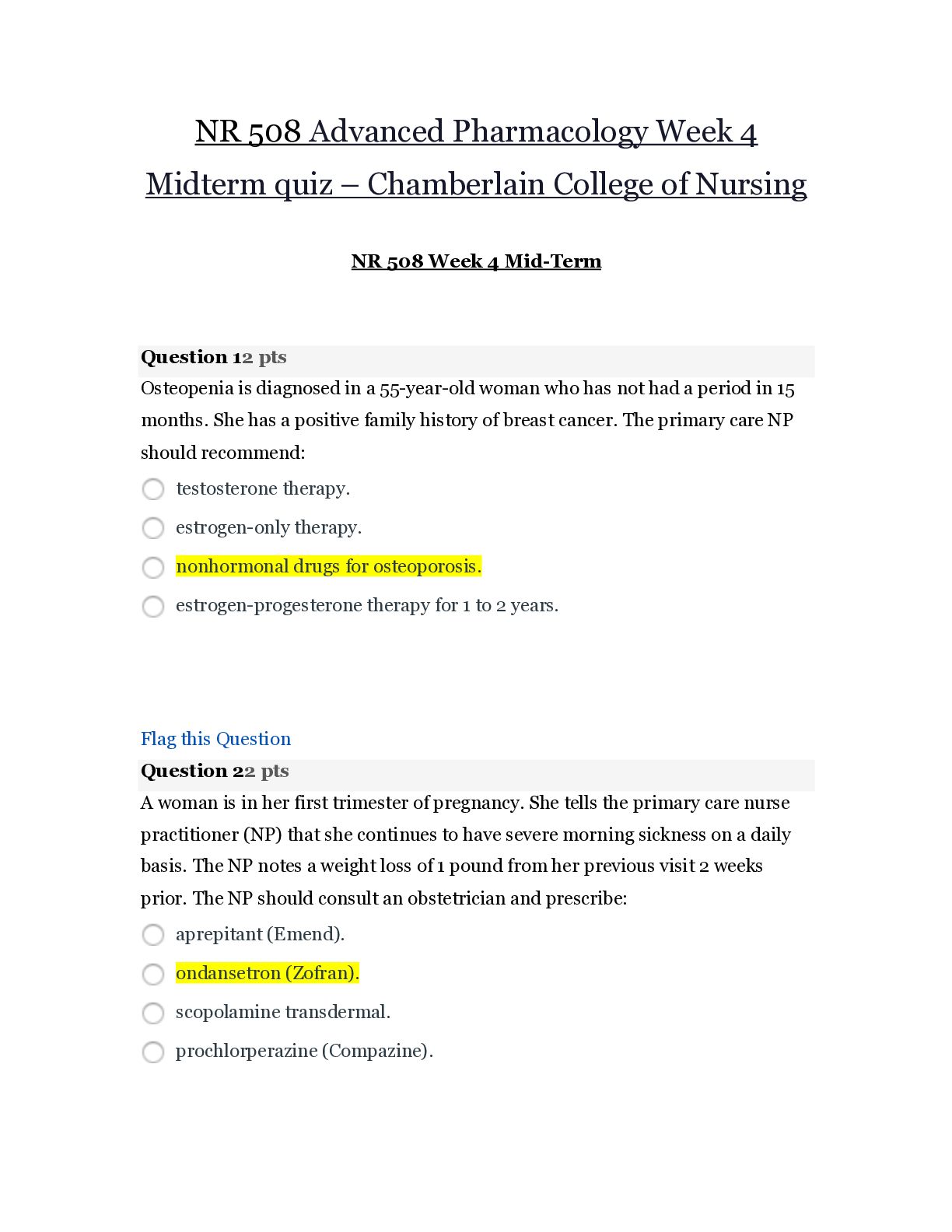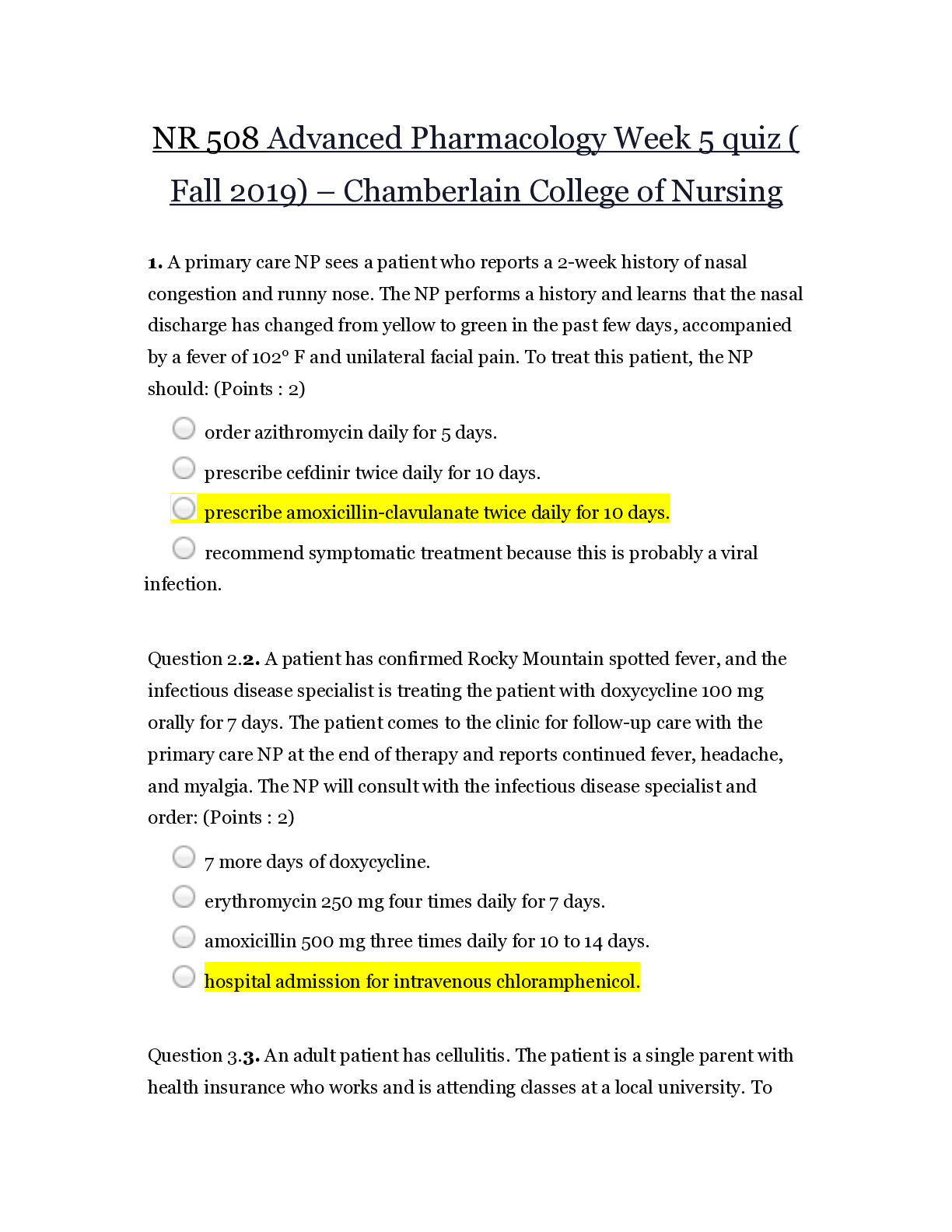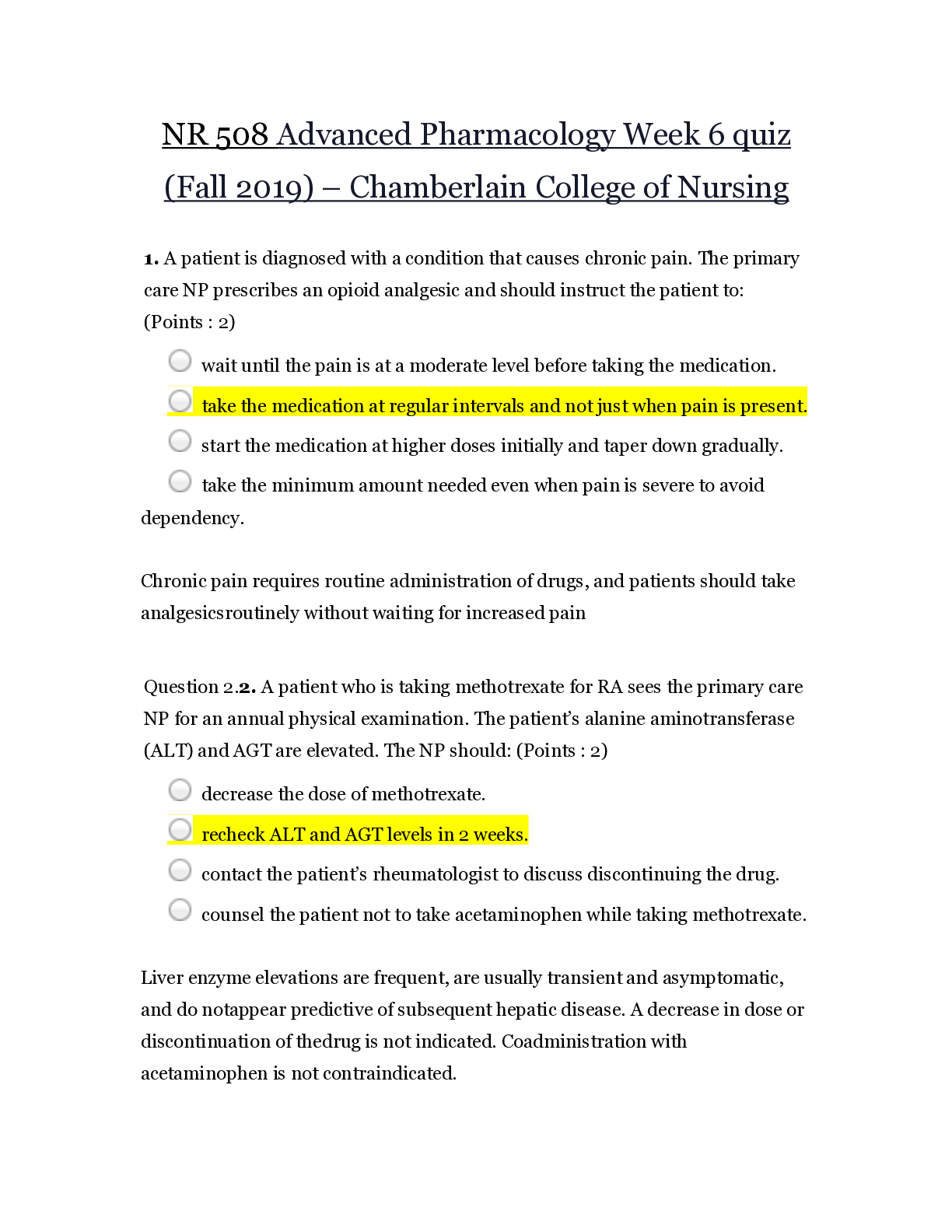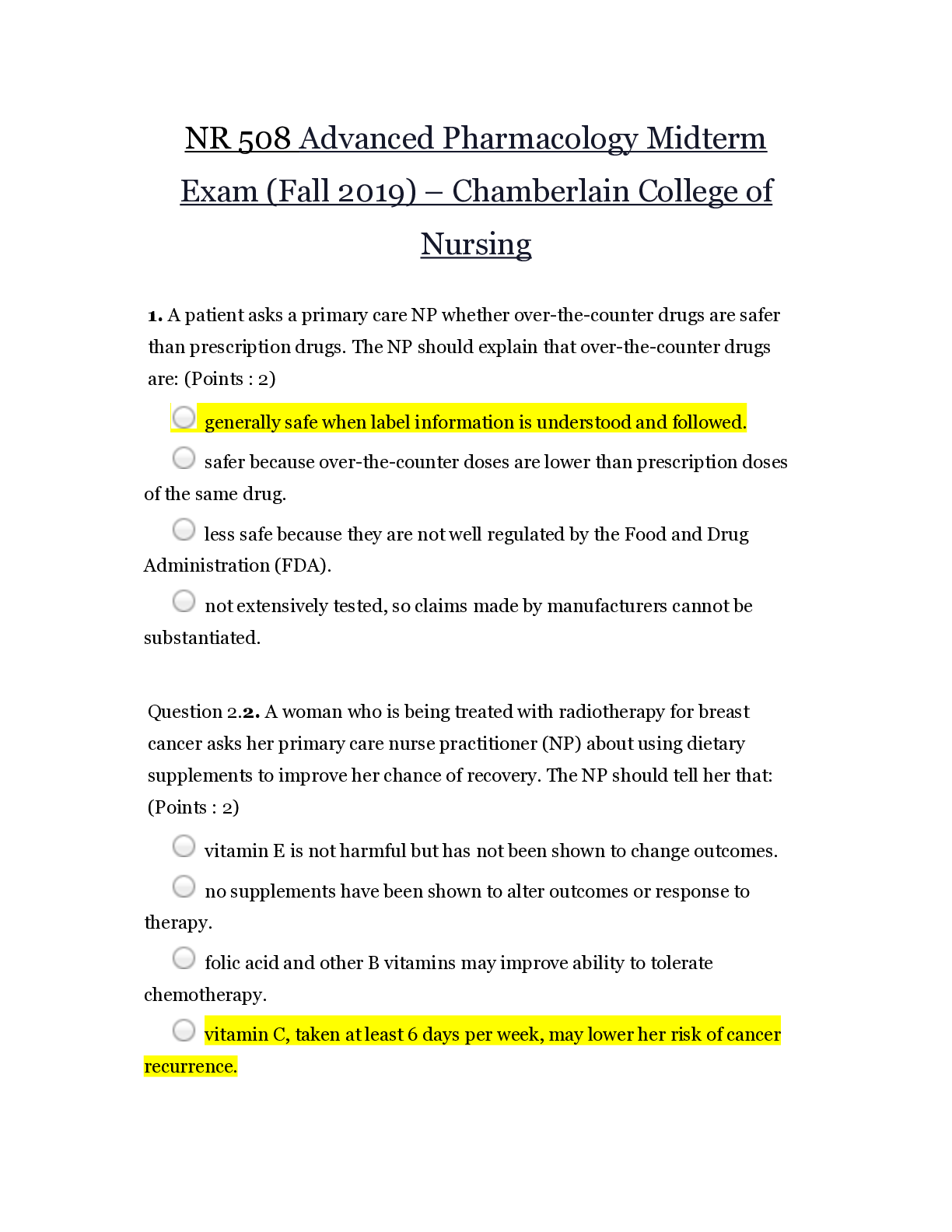Pharmacology > EXAM > NR 508 Advanced Pharmacology Quiz 4 Spring 2019 – Chamberlain College of Nursing / NR508 Advanced (All)
NR 508 Advanced Pharmacology Quiz 4 Spring 2019 – Chamberlain College of Nursing / NR508 Advanced Pharmacology Quiz 4 Spring 2019
Document Content and Description Below
NR 508 Advanced Pharmacology Quiz 4 Spring 2019 – Chamberlain College of Nursing Common mistakes practitioners make in treating anxiety disorders include: 1. Switching medications after an 8- to ... 12-week trial 2. Maximizing dosing of antianxiety medications 3. Encouraging exercise and relaxation therapy before starting medication 4. Thinking a partial response to medication is acceptable An appropriate first-line drug to try for mild to moderate generalized anxiety disorder would be: 1. Alprazolam (Xanax) 2. Diazepam (Valium) 3. Buspirone (Buspar) 4. Amitriptyline (Elavil) An appropriate drug to initially treat panic disorder is: 1. Alprazolam (Xanax) 2. Diazepam (Valium) 3. Buspirone (Buspar) 4. Amitriptyline (Elavil) Prior to starting antidepressants, patients should have laboratory testing to rule out: 1. Hypothyroidism 2. Anemia 3. Diabetes mellitus 4. Low estrogen levels David is a 34-year-old patient who is starting on paroxetine (Paxil) for depression. David's education regarding his medication would include: 1. Paroxetine may cause intermittent diarrhea. 2. He may experience sexual dysfunction beginning a month after he starts therapy. 3. He may have constipation and he should increase fluids and fiber. 4. Paroxetine has a long half-life so he may occasionally skip a dose. Jamison has been prescribed citalopram (Celexa) to treat his depression. Education regarding how quickly selective serotonin reuptake inhibitor (SSRI) antidepressants work would be: 1. Appetite and concentration improve in the first 1 to 2 weeks. 2. Sleep should improve almost immediately upon starting citalopram. 3. Full response to the SSRI may take 2 to 4 months after he reaches the full therapeutic dose. 4. His dysphoric mood will improve in 1 to 2 weeks. An appropriate drug for the treatment of depression with anxiety would be: 1. Alprazolam (Xanax) 2. Escitalopram (Lexapro) 3. Buspirone (Buspar) 4. Amitriptyline (Elavil) An appropriate first-line drug for the treatment of depression with fatigue and low energy would be: 1. Venlafaxine (Effexor) 2. Escitalopram (Lexapro) 3. Buspirone (Buspar) 4. Amitriptyline (Elavil) The laboratory monitoring required when a patient is on a selective serotonin reuptake inhibitor is: 1. Complete blood count every 3 to 4 months 2. Therapeutic blood levels every 6 months after a steady state is achieved 3. Blood glucose every 3 to 4 months 4. There is no laboratory monitoring required Jaycee has been on escitalopram (Lexapro) for a year and is willing to try tapering off of the selective serotonin reuptake inhibitor. What is the initial dosage adjustment when starting a taper off antidepressants? 1. Change dose to every other day dosing for a week 2. Reduce dose by 50% for 3 to 4 days 3. Reduce dose by 50% every other day 4. Escitalopram (Lexapro) can be stopped abruptly due to its long half-life The longer-term Xanax patient comes in and states they need a higher dose of the medication. They deny any additional, new, or accelerating triggers of their anxiety. What is the probable reason? 1. They have become tolerant of the medication, which is characterized by the need for higher and higher doses. 2. They are a drug seeker. 3. They are suicidal. 4. They only need additional counseling on lifestyle modification. What "onset of action" symptoms should be reviewed with patients who have been newly prescribed a selective serotonin reuptake inhibitor? 1. They will have insomnia for a week. 2. They can feel a bit of nausea, but this resolves in a week. 3. They will have an "onset seizure" but this is considered normal. 4. They will no longer dream. Which of the following should not be taken with a selective serotonin reuptake inhibitor? 1. Aged blue cheese 2. Grapefruit 3. Alcohol 4. Green leafy vegetables Why is the consistency of taking paroxetine (Paxil) and never running out of medication more important than with most other selective serotonin reuptake inhibitors (SSRIs)? 1. It has a shorter half-life and withdrawal syndrome has a faster onset without taper. 2. It has the longest half-life and the withdrawal syndrome has a faster onset. 3. It is quasi-addictive in the dopaminergic reward system. 4. It is the most activating of SSRI medications and will cause the person to have sudden deep sadness. The patient shares with the provider that he is taking his Prozac at night before going to bed. What is the best response? 1. This is a good idea because this class of medications generally makes people sleepy. 2. Have you noticed that you are having more sleep issues since you started that? 3. This a good way to remember to take your daily medications because it is near your toothbrush. 4. This is a good plan because you can eat grapefruit if there is 8-12 hours difference in the time each are ingested. Nicotine withdrawal symptoms include: 1. Nervousness 2. Increased appetite 3. Difficulty concentrating 4. All of the above If a patient wants to quit smoking, nicotine replacement therapy is recommended if the patient: 1. Smokes more than 10 cigarettes a day 2. Smokes within 30 minutes of awakening in the morning 3. Smokes when drinking alcohol 4. All of the above Instructions for a patient who is starting nicotine replacement therapy include: 1. Smoke less than 10 cigarettes a day when starting nicotine replacement. 2. Nicotine replacement will help with the withdrawal cravings associated with quitting tobacco. 3. Nicotine replacement can be used indefinitely. 4. Nicotine replacement therapy is generally safe for all patients. Nicotine replacement therapy should not be used in which patients? 1. Pregnant women 2. Patients with worsening angina pectoris 3. Patients who have just suffered an acute myocardial infarction 4. All of the above Instructions for the use of nicotine gum include: 1. Chew the gum quickly to get a peak effect. 2. The gum should be "parked" in the buccal space between chewing. 3. Acidic drinks such as coffee help with the absorption of the nicotine. 4. The highest abstinence rates occur if the patient chews the gum when he or she is having cravings. Patients who choose the nicotine lozenge to assist in quitting tobacco should be instructed: 1. Chew the lozenge well. 2. Drink at least 8 ounces of water after the lozenge dissolves. 3. Use one lozenge every 1 to 2 hours (at least nine per day with a maximum of 20 per day). 4. A tingling sensation in the mouth should be reported to the provider. Transdermal nicotine replacement (the patch) is an effective choice in tobacco cessation because: 1. The patch provides a steady level of nicotine without reinforcing oral aspects of smoking. 2. There is the ability to "fine tune" the amount of nicotine that is delivered to the patient at any one time. 3. There is less of a problem with nicotine toxicity than other forms of nicotine replacement. 4. Transdermal nicotine is safer in pregnancy. The most common adverse effect of the transdermal nicotine replacement patch is: 1. Nicotine toxicity 2. Tingling at the site of patch application 3. Skin irritation under the patch site 4. Life-threatening dysrhythmias If a patient is exhibiting signs of nicotine toxicity when using transdermal nicotine, they should remove the patch and: 1. Wash the area thoroughly with soap and water. 2. Flush the area with clear water. 3. Reapply a new patch in 8 hours. 4. Take acetaminophen for the headache associated with toxicity. When a patient is prescribed nicotine nasal spray for tobacco cessation, instructions include: 1. Inhale deeply with each dose to ensure deposition in the lungs. 2. The dose is one to two sprays in each nostril per hour, not to exceed 40 sprays per day. 3. If they have a sensation of "head rush" this indicates the medication is working well. 4. Nicotine spray may be used for up to 12 continuous months. If prescribing bupropion (Zyban) for tobacco cessation, the instructions to the patient include: 1. Bupropion (Zyban) is started 1 to 2 weeks before the quit date. 2. Nicotine replacement products should not be used with bupropion. 3. If they smoke when taking bupropion they may have increased anxiety and insomnia. 4. Because they are not using bupropion as an antidepressant, they do not need to worry about increased suicide ideation when starting therapy. Varenicline (Chantix) may be prescribed for tobacco cessation. Instructions to the patient who is starting varenicline include: 1. The maximum time varenicline can be used is 12 weeks. 2. Nausea is a sign of varenicline toxicity and should be reported to the provider. 3. The starting regimen for varenicline is start taking 1 mg twice a day a week before the quit date. 4. Neuropsychiatric symptoms may occur. The most appropriate smoking cessation prescription for pregnant women is: 1. A nicotine replacement patch at the lowest dose available 2. Bupropion (Zyban) 3. Varenicline (Chantix) 4. Nonpharmacologic measures Charlie is a 65-year-old male who has been diagnosed with hypertension and benign prostatic hyperplasia. Doxazosin has been chosen to treat his hypertension because it: 1. Increases peripheral vasoconstriction 2. Decreases detrusor muscle contractility 3. Lowers supine blood pressure more than standing pressure 4. Relaxes smooth muscle in the bladder neck To reduce potential adverse effects, patients taking a peripherally acting alpha1 antagonist should do all of the following EXCEPT: 1. Take the dose at bedtime 2. Sit up slowly and dangle their feet before standing 3. Monitor their blood pressure and skip a dose if the pressure is less than 120/80 4. Weigh daily and report weight gain of greater than 2 pounds in one day John has clonidine, a centrally acting adrenergic blocker, prescribed for his hypertension. He should: 1. Not miss a dose or stop taking the drug because of potential rebound hypertension 2. Increase fiber in the diet to treat any diarrhea that may occur 3. Reduce fluid intake to less than 2 liters per day to prevent fluid retention 4. Avoid sitting for long periods, as this can lead to deep vein thrombosis Clonidine has several off-label uses, including: 1. Alcohol and nicotine withdrawal 2. Post-herpetic neuralgia 3. Both 1 and 2 4. Neither 1 nor 2 Jim is being treated for hypertension. Because he has a history of heart attack, the drug chosen is atenolol. Beta blockers treat hypertension by: 1. Increasing heart rate to improve cardiac output 2. Reducing vascular smooth muscle tone 3. Increasing aldosterone-mediated volume activity 4. Reducing aqueous humor production Which of the following adverse effects are less likely in a beta1-selective blocker? 1. Dysrhythmias 2. Impaired insulin release 3. Reflex orthostatic changes 4. Decreased triglycerides and cholesterol Richard is 70 years old and has a history of cardiac dysrhythmias. He has been prescribed nadolol. You do his annual laboratory work and find a CrCl of 25 ml/min. What action should you take related to his nadolol? 1. Extend the dosage interval. 2. Decrease the dose by 75%. 3. Take no action because this value is expected in the older adult. 4. Schedule a serum creatinine level to validate the CrCl value. Beta blockers are the drugs of choice for exertional angina because they: 1. Improve myocardial oxygen supply by vasodilating the coronary arteries 2. Decrease myocardial oxygen demand by decreasing heart rate and vascular resistance 3. Both 1 and 2 4. Neither 1 nor 2 Adherence to beta blocker therapy may be affected by their: 1. Short half-lives requiring twice daily dosing 2. Tendency to elevate lipid levels 3. Effects on the male genitalia, which may produce impotence 4. None of the above Beta blockers have favorable effects on survival and disease progression in heart failure. Treatment should be initiated when the: 1. Symptoms are severe 2. Patient has not responded to other therapies 3. Patient has concurrent hypertension 4. Left ventricular dysfunction is diagnosed Abrupt withdrawal of beta blockers can be life threatening. Patients at highest risk for serious consequences of rapid withdrawal are those with: 1. Angina 2. Coronary artery disease 3. Both 1 and 2 4. Neither 1 nor 2 To prevent life-threatening events from rapid withdrawal of a beta blocker: 1. The dosage interval should be increased by 1 hour each day. 2. An alpha blocker should be added to the treatment regimen before withdrawal. 3. The dosage should be tapered over a period of weeks. 4. The dosage should be decreased by one-half every 4 days. Beta blockers are prescribed for diabetics with caution because of their ability to produce hypoglycemia and block the common symptoms of it. Which of the following symptoms of hypoglycemia is not blocked by these drugs and so can be used to warn diabetics of possible decreased blood glucose? 1. Dizziness 2. Increased heart rate 3. Nervousness and shakiness 4. Diaphoresis Combined alpha-beta antagonists are used to reduce the progression of heart failure because they: 1. Vasodilate the peripheral vasculature 2. Decrease cardiac output 3. Increase renal vascular resistance 4. Reduce atherosclerosis secondary to elevated serum lipoproteins Carvedilol is heavily metabolized by CYP2D6 and 2C9, resulting in drug interactions with which of the following drug classes? 1. Histamine 2 blockers 2. Quinolones 3. Serotonin re-uptake inhibitors 4. All of the above Alpha-beta blockers are especially effective to treat hypertension for which ethnic group? 1. White 2. Asian 3. African American 4. Native American Bethanechol: 1. Increases detrusor muscle tone to empty the bladder 2. Decreases gastric acid secretion to treat peptic ulcer disease 3. Stimulates voluntary muscle tone to improve strength 4. Reduces bronchial airway constriction to treat asthma Clinical dosing of Bethanechol: 1. Begins at the highest effective dose to obtain a rapid response 2. Starts at 5 mg to 10 mg PO and is repeated every hour until a satisfactory clinical response is achieved 3. Requires dosing only once daily 4. Is the same for both the oral and parenteral route Patients who need to remain alert are taught to avoid which drug due to its antimuscarinic effects? 1. Levothyroxine 2. Prilosec 3. Dulcolax 4. Diphenhydramine Anticholinesterase inhibitors are used to treat: 1. Peptic ulcer disease 2. Myasthenia gravis 3. Both 1 and 2 4. Neither 1 nor 2 Which of the following drugs used to treat Alzheimer's disease is not an anticholinergic? 1. Donepezil 2. Memantine 3. Rivastigmine 4. Galantamine Taking which drug with food maximizes it bioavailability? 1. Donepezil 2. Galantamine 3. Rivastigmine 4. Memantine Which of the following drugs should be used only when clearly needed in pregnant and breastfeeding women? 1. Memantine 2. Pyridostigmine 3. Galantamine 4. Rivastigmine There is a narrow margin between first appearance of adverse reaction to AChE inhibitors and serious toxic effects. Adverse reactions that require immediate action include: 1. Dizziness and headache 2. Nausea 3. Decreased salivation 4. Fasciculations of voluntary muscles Adherence is improved when a drug can be given once daily. Which of the following drugs can be given once daily? 1. Tacrine 2. Donepezil 3. Memantine 4. Pyridostigmine Nicotine has a variety of effects on nicotinic receptors throughout the body. Which of the following is NOT an effect of nicotine? 1. Vasodilation and decreased heart rate 2. Increased secretion of gastric acid and motility of the GI smooth muscle 3. Release of dopamine at the pleasure center 4. Stimulation of the locus coeruleus Nicotine gum products are: 1. Chewed to release the nicotine and then swallowed for a systemic effect 2. "Parked" in the buccal area of the mouth to produce a constant amount of nicotine release 3. Bound to exchange resins so the nicotine is only released during chewing 4. Approximately the same in nicotine content as smoking two cigarettes Nicotine replacement therapy (NRT): 1. Is widely distributed in the body only when the gum products are used 2. Does not cross the placenta and so is safe for pregnant women 3. Delays healing of esophagitis and peptic ulcers 4. Has no drug interactions when a transdermal patch is used Success rates for smoking cessation using NRT: 1. Are about the same regardless of the method chosen 2. Vary from 40% to 50% at 12 months 3. Both 1 and 2 4. Neither 1 nor 2 Cholinergic blockers are used to: 1. Counteract the extrapyramidal symptoms (EPS) effects of phenothiazines 2. Control tremors and relax smooth muscle in Parkinson's disease 3. Inhibit the muscarinic action of ACh on bladder muscle 4. All of the above Several classes of drugs have interactions with cholinergic blockers. Which of the following is true about these interactions? 1. Drugs with a narrow therapeutic range given orally may not stay in the GI tract long enough to produce an action. 2. Additive antimuscarinic effects may occur with antihistamines. 3. Cholinergic blockers may decrease the sedative effects of hypnotics. 4. Cholinergic blockers are contraindicated with antipsychotics. Scopolamine can be used to prevent the nausea and vomiting associated with motion sickness. The patient is taught to: 1. Apply the transdermal disk at least 4 hours before the antiemetic effect is desired. 2. Swallow the tablet 1 hour before traveling where motion sickness is possible. 3. Place the tablet under the tongue and allow it to dissolve. 4. Change the transdermal disk daily for maximal effect. You are managing the care of a patient recently diagnosed with benign prostatic hyperplasia (BPH). He is taking tamsulosin but reports dizziness when standing abruptly. The best option for this patient is: 1. Continue the tamsulosin because the side effect will resolve with continued treatment. 2. Discontinue the tamsulosin and start doxazosin. 3. Have him double his fluid intake and stand more slowly. 4. Prescribe meclizine as needed for the dizziness. You are treating a patient with a diagnosis of Alzheimer's disease. The patient's wife mentions difficulty with transportation to the clinic. Which medication is the best choice? 1. Donepezil 2. Tacrine 3. Doxazosin 4. Verapamil A patient presents with a complaint of dark stools and epigastric pain described as gnawing and burning. Which of the medications is the most likely cause? 1. Acetaminophen 2. Estradiol 3. Donepezil 4. Bethanechol Your patient calls for an appointment before going on vacation. Which medication should you ensure he has an adequate supply of before leaving to avoid life-threatening complications? 1. Carvedilol 2. Donepezil 3. Bethanechol 4. Tacrine Activation of central alpha2 receptors results in inhibition of cardioacceleration and ______________ centers in the brain. 1. Vasodilation 2. Vasoconstriction 3. Cardiovascular 4. Respiratory Sarah, a 42-year-old female, requests a prescription for an anorexiant to treat her obesity. A trial of phentermine is prescribed. Prescribing precautions include: 1. Understanding that obesity is a contraindication to prescribing phentermine 2. Anorexiants may cause tolerance and should only be prescribed for 6 months 3. Patients should be monitored for postural hypotension 4. Renal function should be monitored closely while on anorexiants Before prescribing phentermine to Sarah, a thorough drug history should be taken including assessing for the use of serotonergic agents such as selective serotonin reuptake inhibitors (SSRIs) and St John's wort due to: 1. Additive respiratory depression risk 2. Additive effects affecting liver function 3. The risk of serotonin syndrome 4. The risk of altered cognitive functioning Antonia is a 3-year-old child who has a history of status epilepticus. Along with her routine antiseizure medication, she should also have a home prescription for_________ to be used for an episode of status epilepticus. 1. IV phenobarbital 2. Rectal diazepam (Diastat) 3. IV phenytoin (Dilantin) 4. Oral carbamazepine (Tegretol) Rabi is being prescribed phenytoin for seizures. Monitoring includes assessing: 1. For phenytoin hypersensitivity syndrome 3 to 8 weeks after starting treatment 2. For pedal edema throughout therapy 3. Heart rate at each visit and consider altering therapy if heart rate is less than 60 bpm 4. For vision changes, such as red-green blindness, at least annually Dwayne has recently started on carbamazepine to treat seizures. He comes to see you and you note that while his carbamazepine levels had been in the therapeutic range, they are now low. The possible cause for the low carbamazepine levels include: 1. Dwayne hasn't been taking his carbamazepine because it causes insomnia. 2. Carbamazepine auto-induces metabolism, leading to lower levels in spite of good compliance. 3. Dwayne was not originally prescribed the correct amount of carbamazepine. 4. Carbamazepine is probably not the right antiseizure medication for Dwayne. Carbamazepine has a Black Box Warning due to life-threatening: 1. Renal toxicity, leading to renal failure 2. Hepatotoxicity, leading to liver failure 3. Dermatologic reaction, including Steven's Johnson and toxic epidermal necrolysis 4. Cardiac effects, including supraventricular tachycardia Long-term monitoring of patients who are taking carbamazepine includes: 1. Routine troponin levels to assess for cardiac damage 2. Annual eye examinations to assess for cataract development 3. Monthly pregnancy tests for all women of childbearing age 4. Complete blood count every 3 to 4 months Six-year-old Lucy has recently been started on ethosuximide (Zarontin) for seizures. She should be monitored for: 1. Increased seizure activity, as this drug may auto-induce seizures 2. Altered renal function, including renal failure 3. Blood dyscrasias, which are uncommon but possible 4. Central nervous system excitement, leading to insomnia Sook has been prescribed gabapentin to treat neuropathic pain and is complaining of feeling depressed and having "strange" thoughts. The appropriate initial action would be: 1. Increase her dose 2. Assess for suicidal ideation 3. Discontinue the medication immediately 4. Decrease her dose to half then slowly titrate up the dose Selma, who is overweight, recently started taking topiramate for seizures and at her follow-up visit you note she has lost 3 kg. The appropriate action would be: 1. Tell her to increase her caloric intake to counter the effects of the topiramate. 2. Consult with a neurologist, as this is not a common adverse effect of topiramate. 3. Decrease her dose of topiramate. 4. Reassure her that this is a normal side effect of topiramate and continue to monitor her weight. . Monitoring of a patient on gabapentin to treat seizures includes: 1. Routine therapeutic drug levels every 3 to 4 months 2. Assessing for dermatologic reactions, including Steven's Johnson 3. Routine serum electrolytes, especially in hot weather 4. Recording seizure frequency, duration, and severity Scott's seizures are well controlled on topiramate and he wants to start playing baseball. Education for Scott regarding his topiramate includes: 1. He should not play sports due to the risk of increased seizures 2. He should monitor his temperature and ability to sweat in the heat while playing 3. Reminding him that he may need higher dosages of topiramate when exercising 4. Encouraging him to use sunscreen due to photosensitivity from topiramate Cara is taking levetiracetam (Keppra) to treat seizures. Routine education for levetiracetam includes reminding her: 1. To not abruptly discontinue levetiracetam due to risk for withdrawal seizures 2. To wear sunscreen due to photosensitivity from levetiracetam 3. To get an annual eye exam while on levetiracetam 4. To report weight loss if it occurs Levetiracetam has known drug interactions with: 1. Combined oral contraceptives 2. Carbamazepine 3. Warfarin 4. Few, if any, drugs Zainab is taking lamotrigine (Lamictal) and presents to the clinic with fever and lymphadenopathy. Initial evaluation and treatment includes: 1. Reassuring her she has a viral infection and to call if she isn't better in 4 or 5 days 2. Ruling out a hypersensitivity reaction that may lead to multi-organ failure 3. Rapid strep test and symptomatic care if strep test is negative 4. Observation only, with further assessment if she worsens Samantha is taking lamotrigine (Lamictal) for her seizures and requests a prescription for combined oral contraceptives (COCs), which interact with lamotrigine and may cause: 1. Contraceptive failure 2. Excessive weight gain 3. Reduced lamotrigine levels, requiring doubling the dose of lamotrigine 4. Induction of estrogen metabolism, requiring higher estrogen content OCs be prescribed The tricyclic antidepressants should be prescribed cautiously in patients with: 1. Eczema 2. Asthma 3. Diabetes 4. Heart disease A 66-year-old male was prescribed phenelzine (Nardil) while in an acute psychiatric unit for recalcitrant depression. The NP managing his primary health care needs to understand the following regarding phenelzine and other monoamine oxidase inhibitors (MAOIs): 1. He should not be prescribed any serotonergic drug such as sumatriptan (Imitrex) 2. MAOIs interact with many common foods, including yogurt, sour cream, and soy sauce 3. Symptoms of hypertensive crisis (headache, tachycardia, sweating) require immediate treatment 4. All of the above Taylor is a 10-year-old child diagnosed with major depression. The appropriate first-line antidepressant for children is: 1. Fluoxetine 2. Fluvoxamine 3. Sertraline 4. Escitalopram Suzanne is started on paroxetine (Paxil), a selective serotonin reuptake inhibitor (SSRI), for depression. Education regarding her antidepressant includes: 1. SSRIs may take 2 to 6 weeks before she will have maximum drug effects. 2. Red-green color blindness may occur and should be reported. 3. If she experiences dry mouth or heart rates greater than 80, she should stop taking the drug immediately. 4. She should eat lots of food high in fiber to prevent constipation. Cecilia presents with depression associated with complaints of fatigue, sleeping all the time, and lack of motivation. An appropriate initial antidepressant for her would be: 1. Fluoxetine (Prozac) 2. Paroxetine (Paxil) 3. Amitriptyline (Elavil) 4. Duloxetine (Cymbalta) Jake, a 45-year-old patient with schizophrenia, was recently hospitalized for acute psychosis due to medication noncompliance. He was treated with IM long-acting haloperidol. Besides monitoring his schizophrenia symptoms, the patient should be assessed by his primary care provider: 1. For excessive weight loss 2. With the Abnormal Involuntary Movement Scale (AIMS) for extrapyramidal symptoms (EPS) 3. Monthly for tolerance to the haloperidol 4. Only by the mental health provider, as most NPs in primary care do not care for mentally ill patients Anticholinergic agents, such as benztropine (Cogentin), may be given with a phenothiazine to: 1. Reduce the chance of tardive dyskinesia 2. Potentiate the effects of the drug 3. Reduce the tolerance that tends to occur 4. Increase central nervous system (CNS) depression Patients who are prescribed olanzapine (Zyprexa) should be monitored for: 1. Insomnia 2. Weight gain 3. Hypertension 4. Galactorrhea A 19-year-old male was started on risperidone. Monitoring for risperidone includes observing for common side effects, including: 1. Bradykinesia, akathisia, and agitation 2. Excessive weight gain 3. Hypertension 4. Potentially fatal agranulocytosis In choosing a benzodiazepam to treat anxiety the prescriber needs to be aware of the possibility of dependence. The benzodiazepam with the greatest likelihood of rapidly developing dependence is: 1. Chlordiazepoxide (Librium) 2. Clonazepam (Klonopin) 3. Alprazolam (Xanax) 4. Oxazepam (Serax) A patient with anxiety and depression may respond to: 1. Duloxetine (Cymbalta) 2. Fluoxetine (Prozac) 3. Oxazepam (Serax) 4. Buspirone (Buspar) and an SSRI combined When prescribing temazepam (Restoril) for insomnia, patient education includes: 1. Take temazepam nightly approximately 15 minutes before bedtime. 2. Temazepam should not be used more than three times a week for less than 3 months. 3. Drinking 1 ounce of alcohol will cause additive effects and the patient will sleep better. 4. Exercise for at least 30 minutes within 2 hours of bedtime to enhance the effects of temazepam. Patients should be instructed regarding the rapid onset of zolpidem (Ambien) because: 1. Zolpidem should be taken just before going to bed. 2. Zolpidem may cause dry mouth and constipation. 3. Patients may need to double the dose for effectiveness. 4. They should stop drinking alcohol at least 30 minutes before taking zolpidem. One major drug used to treat bipolar disease is lithium. Because lithium has a narrow therapeutic range, it is important to recognize symptoms of toxicity, such as: 1. Orthostatic hypotension 2. Agitation and irritability 3. Drowsiness and nausea 4. Painful urination and abdominal distention Tom is taking lithium for bipolar disorder. He should be taught to: 1. Take his lithium with food 2. Eat a diet with consistent levels of salt (sodium) 3. Drink at least 2 quarts of water if he is in a hot environment 4. Monitor blood glucose levels Cynthia is taking valproate (Depakote) for seizures and would like to get pregnant. What advice would you give her? 1. Valproate is safe during all trimesters of pregnancy. 2. She can get pregnant while taking valproate, but she should take adequate folic acid. 3. Valproate is not safe at any time during pregnancy. 4. Valproate is a known teratogen, but may be taken after the first trimester if necessary. When prescribing an opioid analgesic such as acetaminophen and codeine (Tylenol #3), instructions to the patient should include: 1. The medication may cause sedation and they should not drive. 2. Constipation is a common side effect and they should increase fluids and fiber. 3. Patients should not take any other acetaminophen-containing medications at the same time. 4. All of the above Kirk sprained his ankle and is asking for pain medication for his mild-to-moderate pain. The appropriate first-line medication would be: 1. Ibuprofen (Advil) 2. Acetaminophen with hydrocodone (Vicodin) 3. Oxycodone (Oxycontin) 4. Oral morphine (Roxanol) Kasey fractured his ankle in two places and is asking for medication for his pain. The appropriate first-line medication would be: 1. Ibuprofen (Advil) 2. Acetaminophen with hydrocodone (Vicodin) 3. Oxycodone (Oxycontin) 4. Oral morphine (Roxanol) Jack, age 8, has attention deficit disorder (ADD) and is prescribed methylphenidate (Ritalin). He and his parents should be educated about the side effects of methylphenidate, which are: 1. Slurred speech and insomnia 2. Bradycardia and confusion 3. Dizziness and orthostatic hypotension 4. Insomnia and decreased appetite Monitoring for a child on methylphenidate for attention deficit hyperactivity disorder (ADHD) includes: 1. ADHD symptoms 2. Routine height and weight checks 3. Amount of methylphenidate being used 4. All of the above When prescribing Adderall (amphetamine and dextroamphetamine) to adults with ADHD the nurse practitioner will need to monitor: 1. Blood pressure 2. Blood glucose levels 3. Urine ketone levels 4. Liver function [Show More]
Last updated: 1 year ago
Preview 1 out of 25 pages

Reviews( 0 )
Document information
Connected school, study & course
About the document
Uploaded On
Jun 03, 2020
Number of pages
25
Written in
Additional information
This document has been written for:
Uploaded
Jun 03, 2020
Downloads
0
Views
89


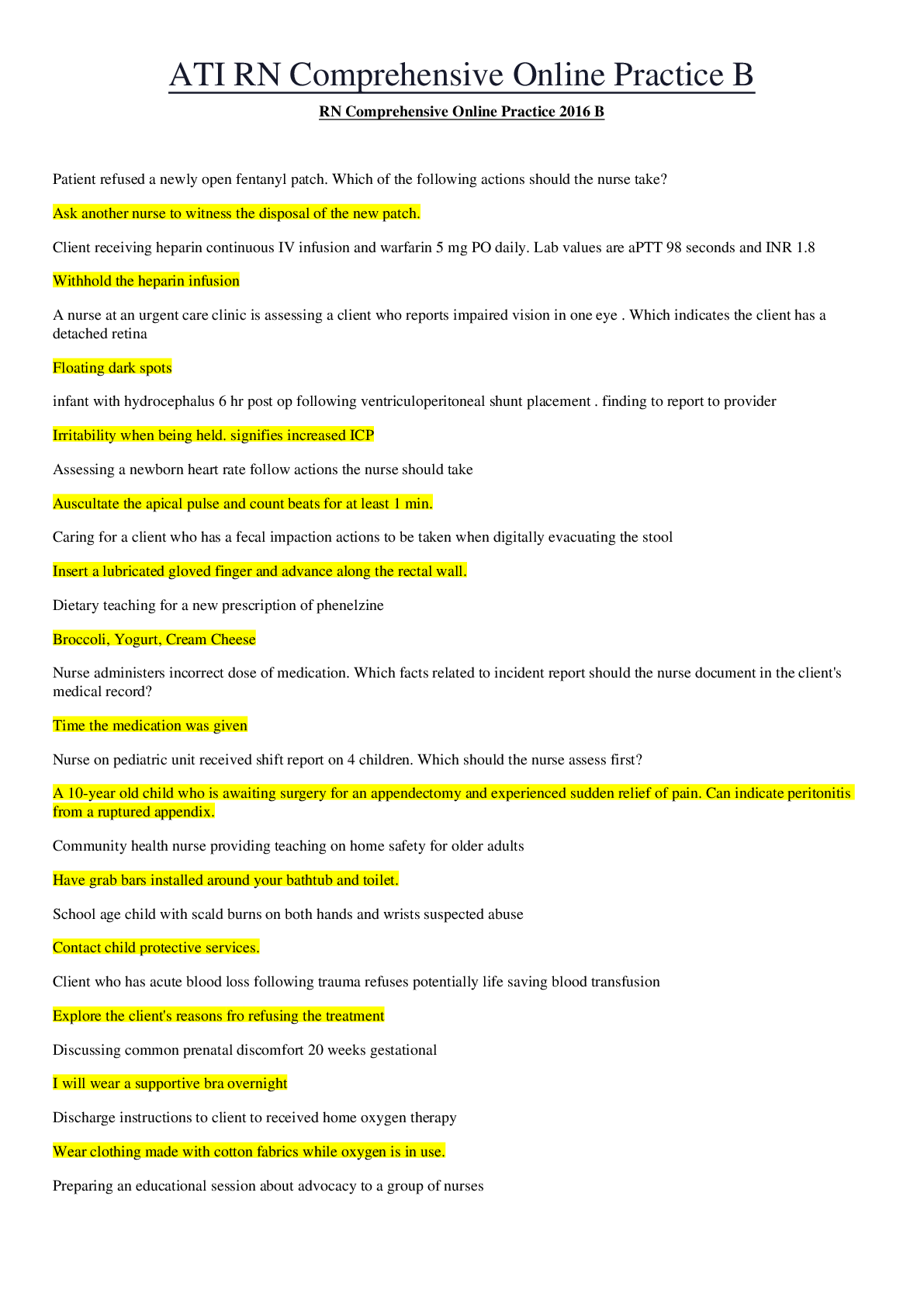
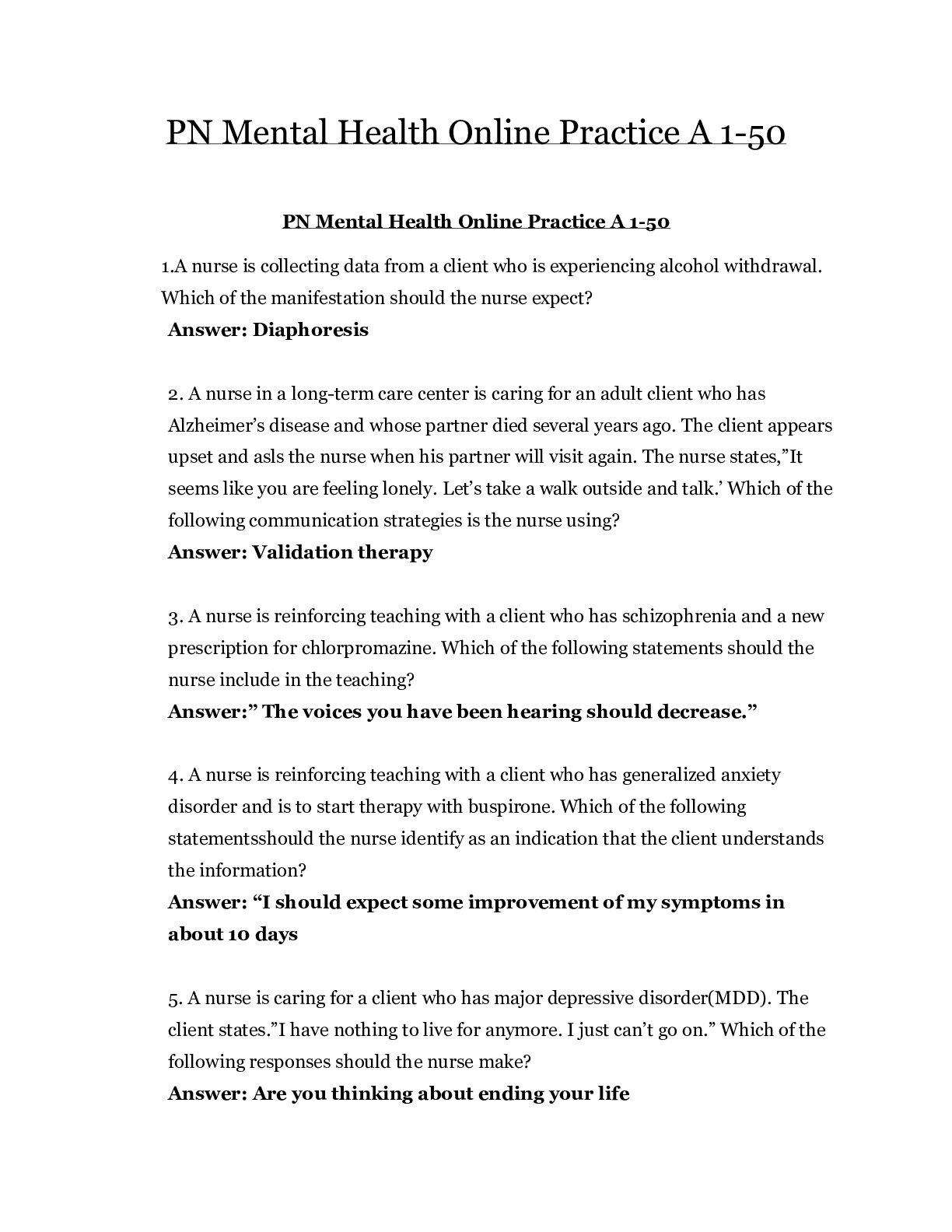
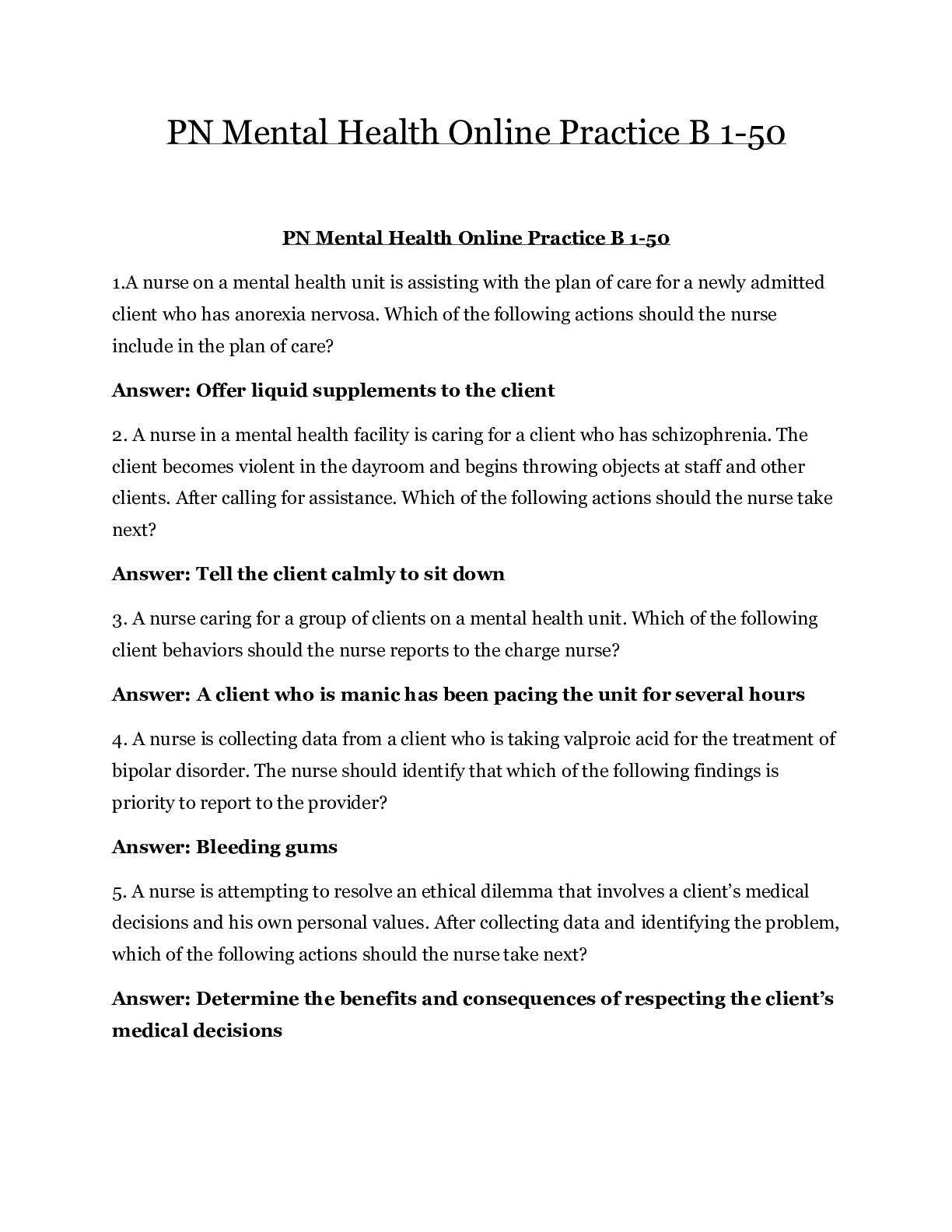
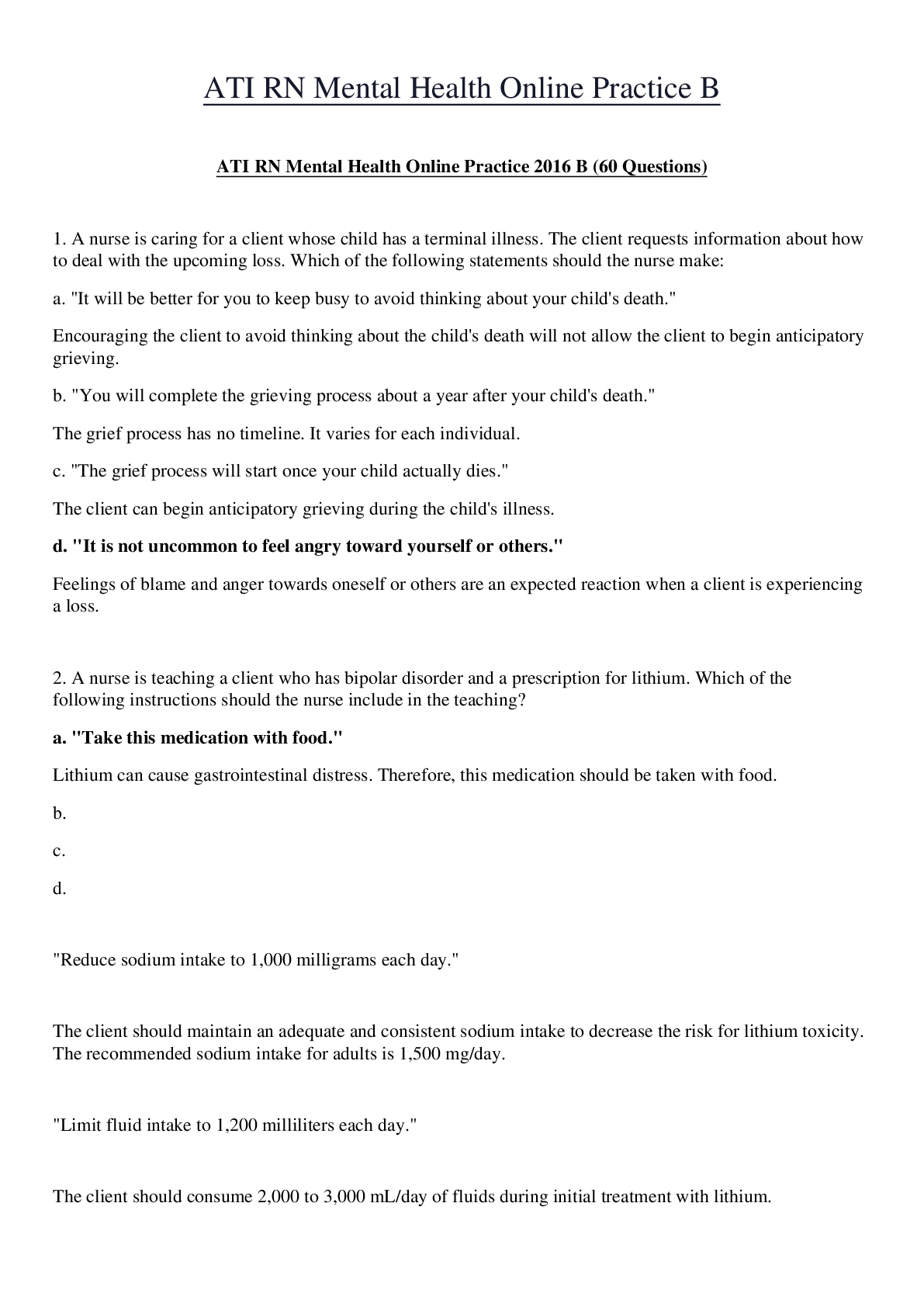


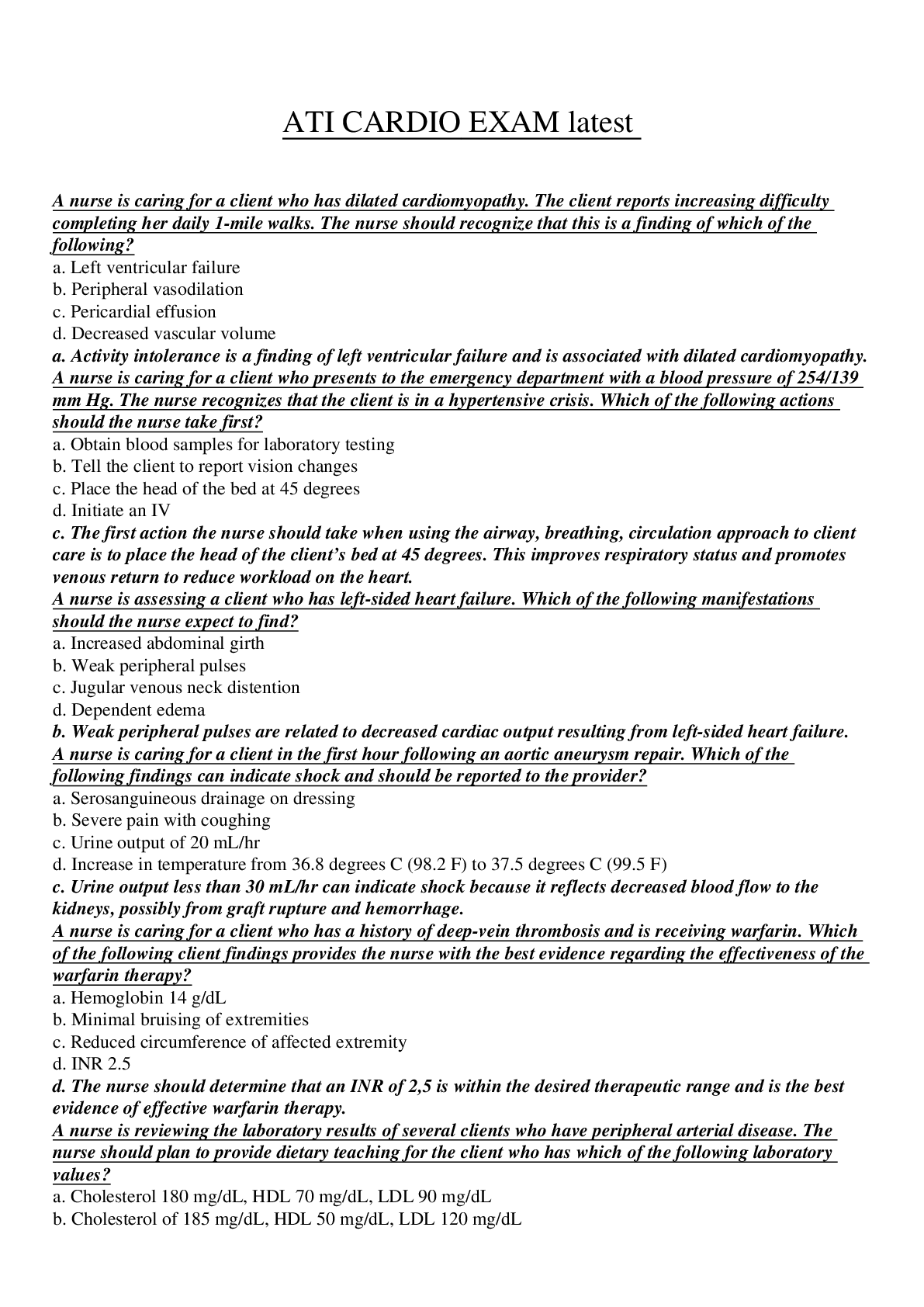
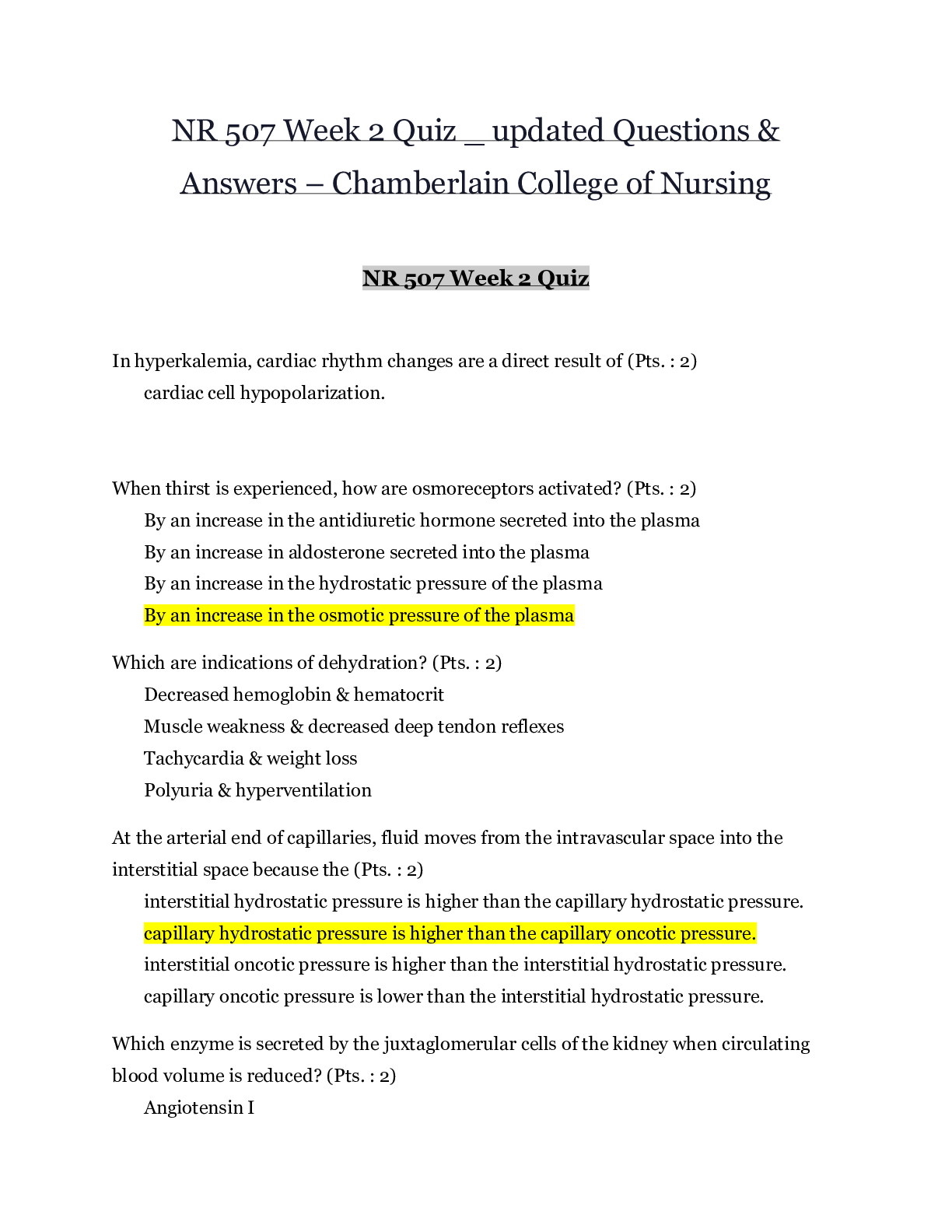
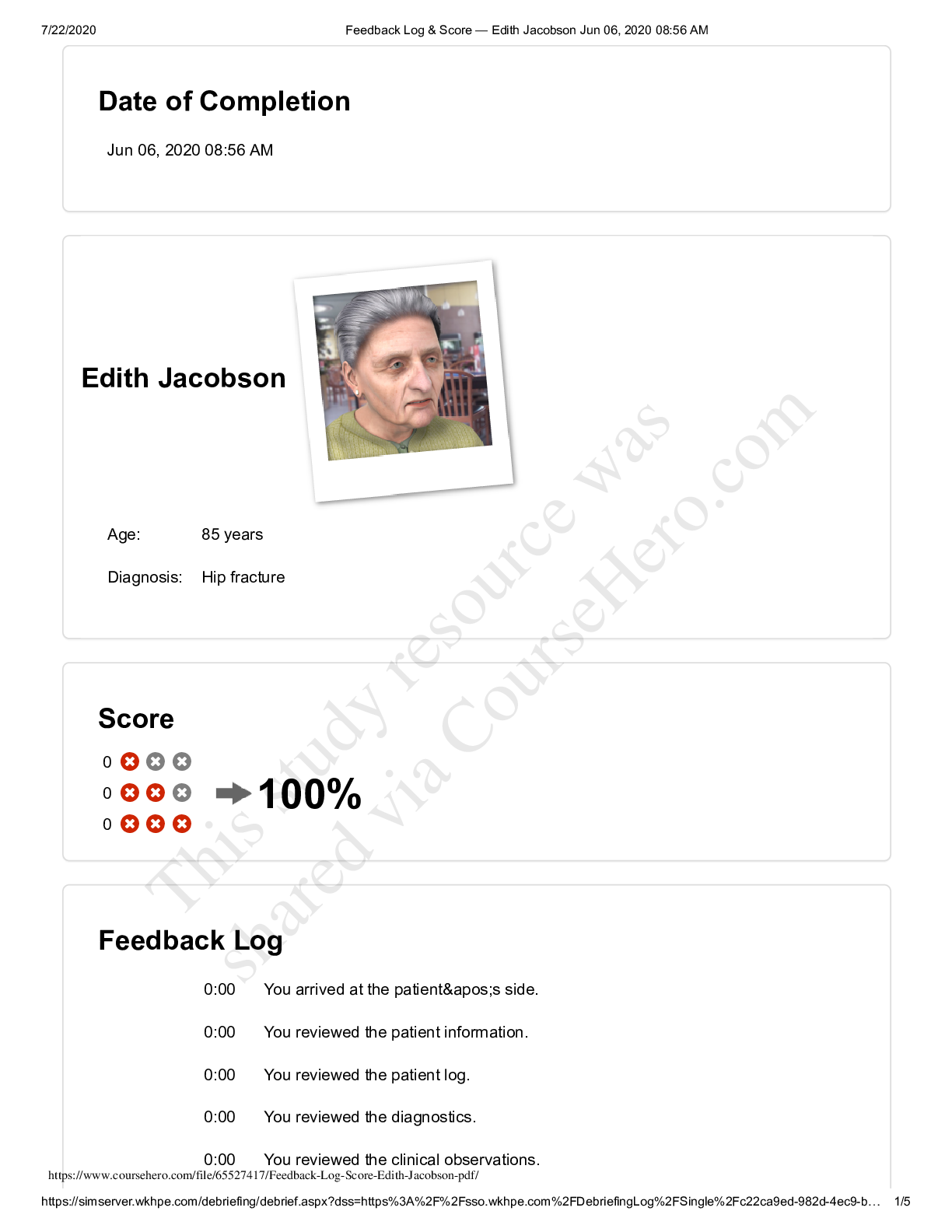
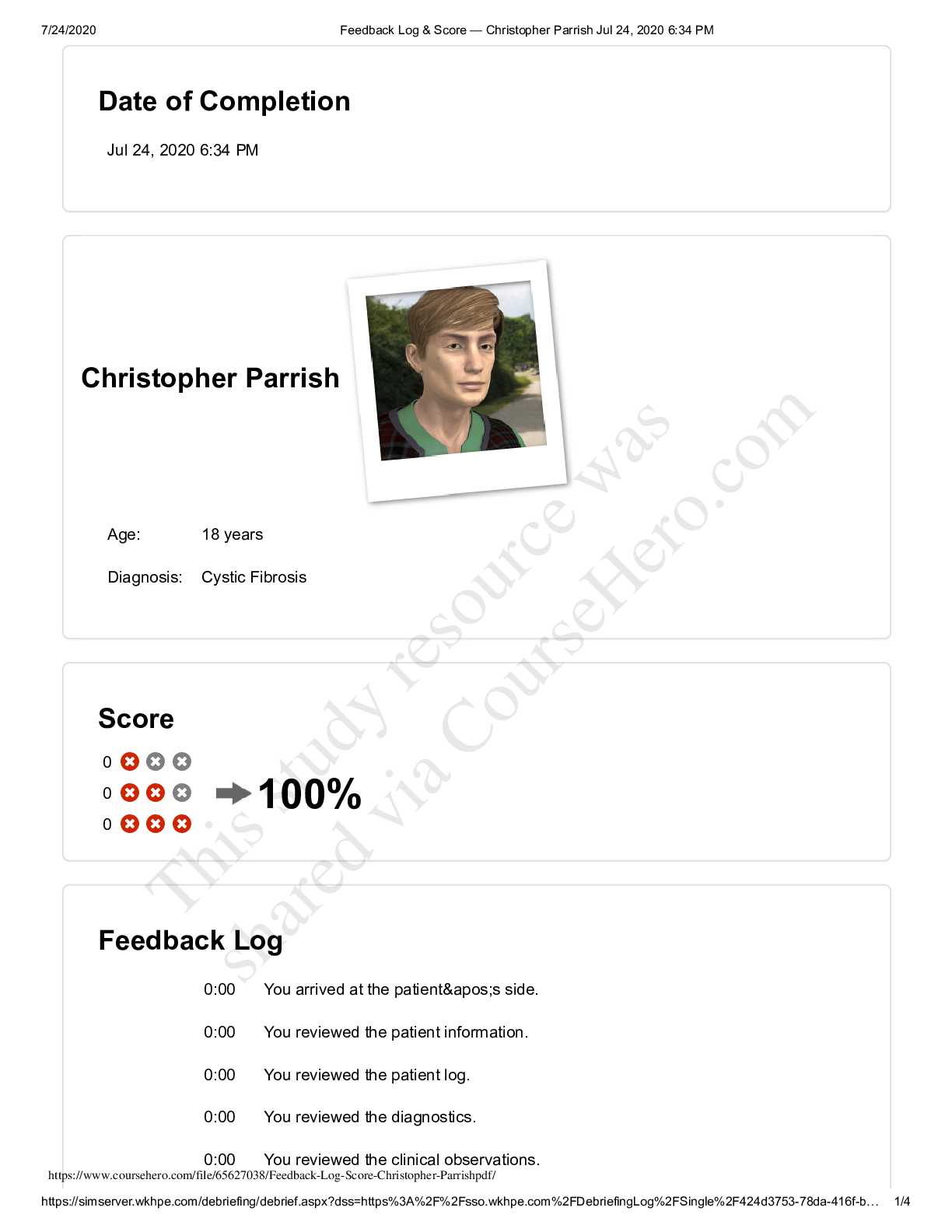
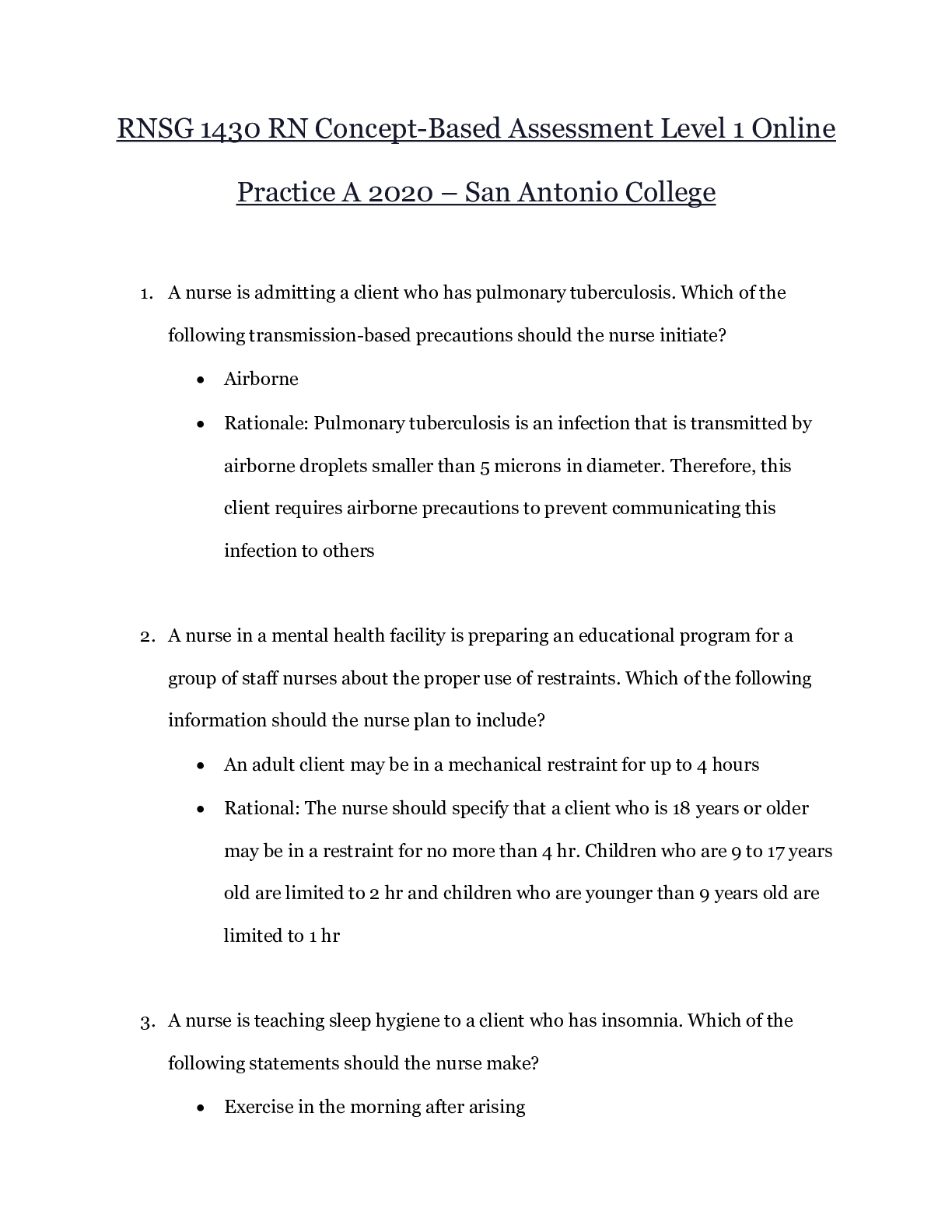


 – CHAMBERLAIN COLLEGE OF NURSING.png)
